How Much Electricity Does A NAS Use and How Much Does it Cost to run 24×7?
Have you SEEN how much electricity costs these days? Because of any one of about a hundred different global factors (local conflict, slow renewable energy uptake, monopolizing energy companies with powerful lobbying – take your pick!) most of us in2022/2023 have seen increases in energy costs. In this energy-aware climate, it can be appreciated that a NAS drive (a 24×7 appliance) seemingly has its cost to the end user in terms of electricity as something of a vague number. With so many kinds of NAS available in the market, featuring a mix of CPUs, PSUs, Bays and utilities, PLUS the wide range of HDD/SSD drives in the market to choose from – there are just so many variables when trying to work out how much power your NAS drive is using and how much that is translating to in your monthly energy bill! So, today’s article is about working out how much electricity several popular NAS setup choices will consume, as well as how much that equals to you in £, $ or € per day, month and year! We tested two popular desktop 4-Bay NAS systems, connected them to energy monitors and worked out how much power they used in full active use and in idle. Let’s begin.

Note – this is a guide on energy use on a NAS drive. If you want to learn more about the energy consumption of your PC running 24×7, there is a great guide over on CCL Online that you can read here.
NAS Power Use Test Setup
Choosing the appropriate NAS drive for these tests was always going to be tough. I DO intend on repeating these tests with several different NAS drives after this, but wanted these first few tests to be focused on the most POPULAR NAS setups, as well as identifying the difference between using newer gen CPUs and Larger drives vs using older generation devices and smaller capacity media. All in all, there were four separate tests, with 2x tests on each NAS+Media configuration. These were a Synology DS920+ and 4x WD Red Plus HDDs (a very, VERY popular NAS setup over the last 2-2.5yrs) and a QNAP TS-464 NAS and 4x WD Red 22TB NAS HDDs (both Summer 2022 Releases and represent ‘New NAS’ with ‘High Capacity’ users in mind. Here is a breakdown of the hardware configurations and test architectures:
- Synology DS920+ or QNAP TS-464 4-Bay Celeron Powered Desktop NAS
- 4x WD Red WD40EFZX 4TB (Synology Test in SHR) or 4x WD Red Pro WD221KFGX 22TB Hard Drives (QNAP Test in RAID 5)
- During ‘ACTIVE’ 24hr Tests, the NAS was prevented from going into standby/idle. 1 VM running, 1-Core and 1GB Memory, 2x IP Cameras recording non-stop, drive S.M.A.R.T tests scheduled to be hourly
- During IDLE 24hr Tests, the VM was deleted, VM and Surveillance Software disabled, ALL S.M.A.R.T tests disabled and network cable (1GbE) disconnected.
- The first day of operation (which includes initialization and RAID creation) not counted (but visible at the start of the graph).
- Power was monitored with a GOSUND SMART KIT Smart Plug, Mini 13A – Find HERE
The initial 24hours (used for system initialization and RAID configuration) were NOT included in the power usage monitoring, as although they appear on the graph they are one-off single-event scenarios. Each test (Active vs Idle) was conducted for 24hrs and the overall electricity usage was displayed in kw (kilowatt). But what is the difference between Active and Idle activity? Why does it matter?
What is the Difference Between a NAS Drive ‘Active’ and in ‘IDLE / Standby’?
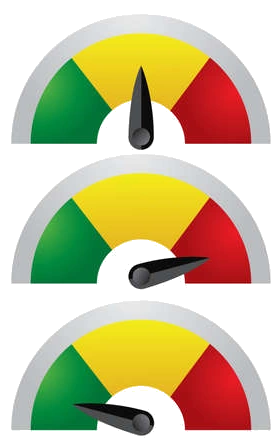
Although a NAS is designed to be in operation 24×7 and is consuming electricity when running, the actual reality of this and the extent to which it is consuming it is actually alot more nuanced. Most home users who have a NAS system will use the NAS directly for a significant;y smaller portion of time per day than it is actually powered on for. Perhaps to stream a movie or a couple of TV episodes, run a daily backup, have a couple of cameras in/outside their home that are sending recordings (or more likely just alerts and associated captures) to the NAS and that is about it. They will periodically do more than these, maybe a VM, more sophisticated backup or use some of the other services ad hoc, but the result is that in most domestic/bog standard home scenarios, a NAS will be switched internally to Idle/Standby after no pro-active use quite quickly and spend 80-90% of the time in low power modes. Business users might well be using the system 24×7 for sync’d tasks and on-going camera recording, but even then, this will be a lower % of system resources in use. So, in order to find a comparable and relative means to study the electricity use of a NAS and it’s cost, I have conducted two tests per NAS+HDD configuration. The first, a 24 Hour Active test, with the system using a decent % of it’s CPU+Memory, a swell as the HDDs not being given the chance to switch to Idle/Standy (by constantly writing AND performing S.M.A.R.T tests hourly). The idle tests involve all of those apps, services and scheduled operations being cancelled and the network cable being disconnected from the NAS (for another 24hrs). From here we can work out the cost of an hour of power usage by either setup in high activity and near-zero activity. But how can we work out the COST of the electricity used by the NAS in that time period?
How Energy Costs in these NAS Tests were Calculated?
The results of the energy usage are then cross-referenced by ‘sust-it.net’ and calculations of the cost of the used electricity per day, month and year was calculated for the UK, U.S, Germany, Australia and Canada. Now, using a select energy tariff is much harder, as there are quite literally thousands of different energy providers globally, each with their own pricing on the cost of energy per ‘kWh’. So, I used the national average calculations that were provided by ‘sust-it’ for each of those areas. Some are clearly more up-to-date than others (i.e the United Kingdom Avg Energy cost tariff is dated October 2022, whereas the Canada’s average energy cost is from way back in March 2020), however, these will still provide a good basis for understanding what a NAS drive is going to cost you in electricity when it is in operation. The national tariff averages used in this article for each region are as follows:
UK: Energy Price (October 2022) electricity rate of 34.00 pence per kWh.
USA: Average (Feb 2022) electricity rate of 14.80 cents per kWh.
Germany: Average (June 2021) electricity rate of 31.93 Eurocents per kWh.
Australia: Average (March 2022) electricity rate of 23.59 cents per kWh.
Canada: Average (2020) electricity rate of 8.50 cents per kWh.
Source – https://www.sust-it.net
There are the rates that we will be using to calculate the running costs of the Synology and QNAP NAS systems (and more importantly their respective WD Drive setups and CPU usage).
Test #1 – Synology DS920+ NAS and 4X 4TB WD Red Drives
In test one, I set the Synology DS920+ NAS and WD Red 4TB Hard drives up in the following configuration for the Active tests:
- Synology DS920+ NAS PSU = 100W External PSU, Intel Celeron J4125 Quad Core 2.0-2.7Ghz, 4GB DDR4 2666Mhz Memory
- WD Red Plus 4TB HDD, SHR
- Surveillance Station 9 and 2x Reolink Dome IP Cameras (24hrs Active)
- Synology Virtual Machine Manager, 1x Windows VM, 1 Core, 1GB Memory (24hrs Active)
- Synology Storage Manager (DSM 7.1) and S.M.A.R.T Tests per Hour (24hr Active)
- Reported Average power requirements of a WD Red Plus 4TB (Single):
- Read/Write: 4.7
- Idle: 3.1
- Standby Sleep: 0.3
|
The Synology DS920+ NAS
Current Price/Availability on Amazon –$550+
|
The WD Red Plus 4TB HDD (x4)
Current Price/Availability on Amazon –$79
|
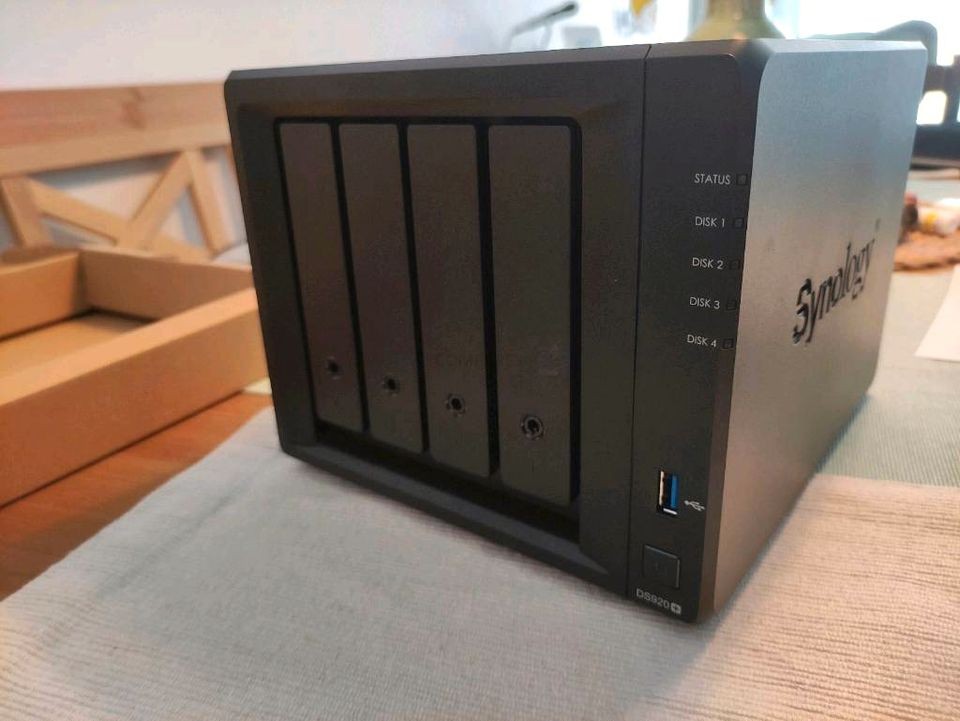 |
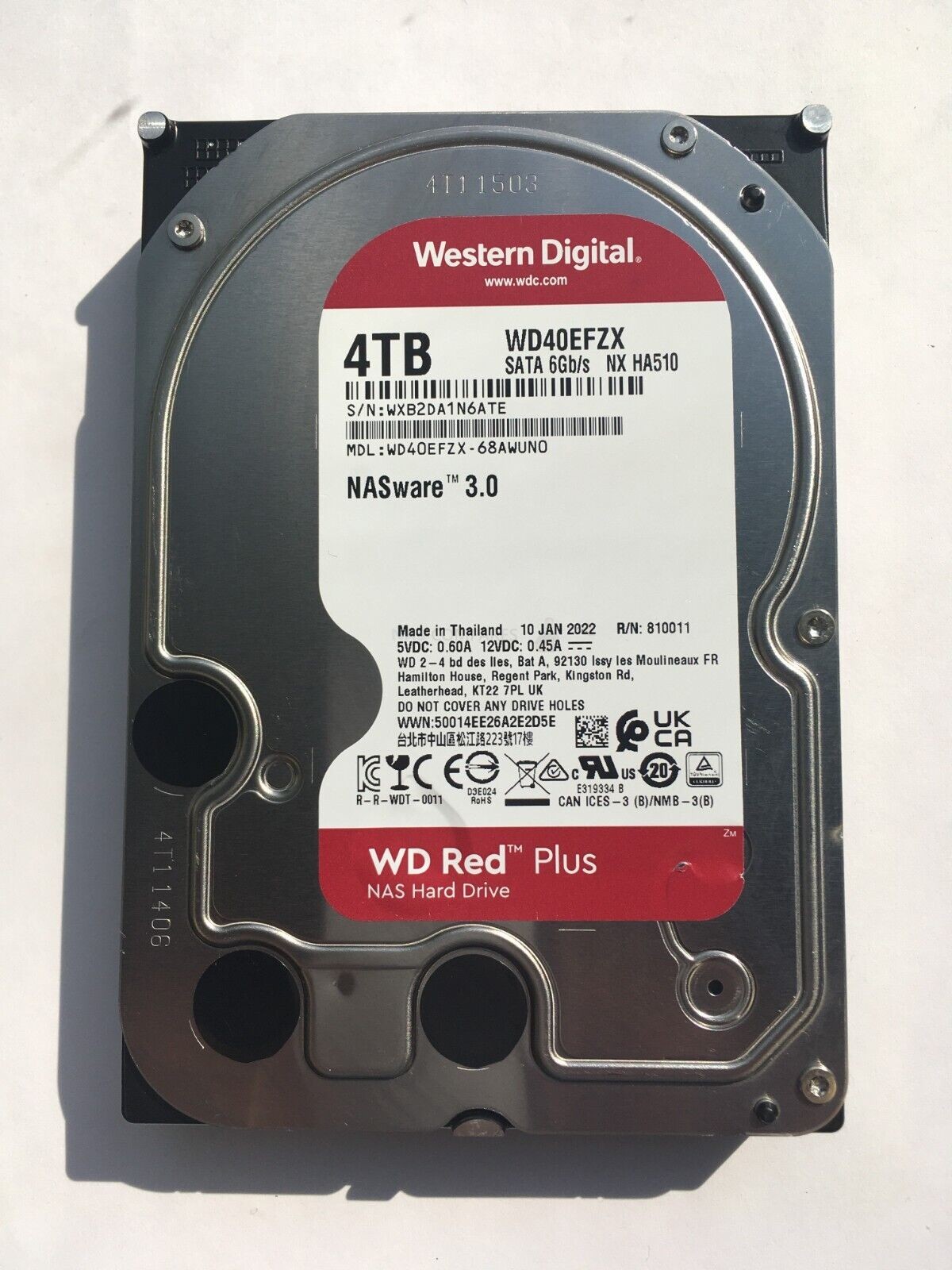 |
|
Intel J4125 CPU, 4-Core 2.0-2.7Ghz Celeron CPU
4GB 2666Mhz non-ECC Memory, 1GbE |
4 Terabyte Capacity – SATA 3.5″ Form Factor
5400RPM – 128MB Cache – 4x 1TB Platters
|
Then, 24hrs later, I disabled all these processes, disconnected the RJ45 LAN and let the NAS fall into idle/standby mode. The results were as follows:
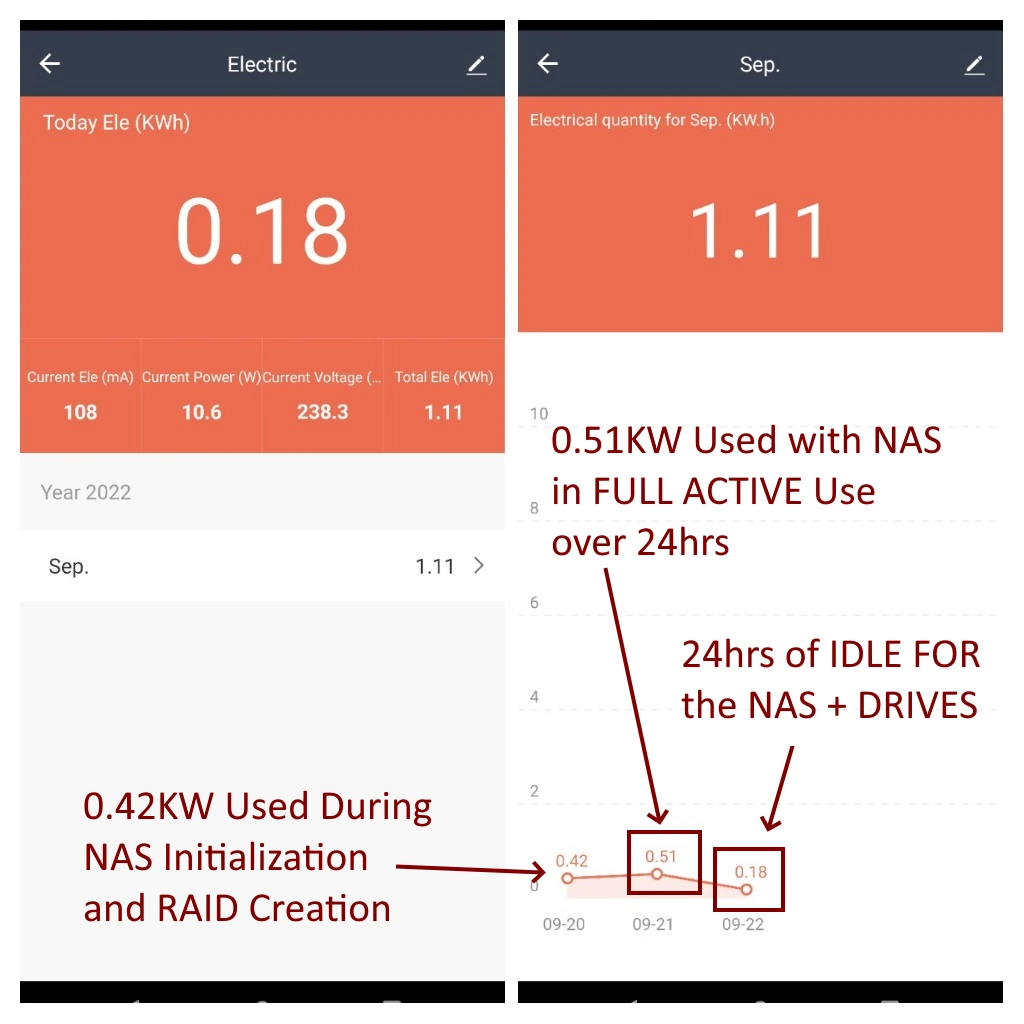
The 0.42kW that was used in the initialization of both the NAS and the drives in the RAID was NOT included in the respective Actie/Idle tests. The 24 hours of Active use energy consumption was 0.51KW
Synology DS920+ and WD Red Plus 4TB HDD Test Results:
0.51KW divided by 24 (hours) = 0.02125kW use per Hour
| 24hr Active Use (0.51KW) | UK Power Use | U.S Power Use | Germany Power Use | Australia | Canada |
| Cost Per Day | £0.1734 | $0.0755 | €0.1628 | AU$0.1203 | CA$0.0433 |
| Cost per Month | £5.27 | $2.29 | €4.95 | AU$3.65 | CA$1.31 |
| Cost Per Year | £63.29 | $27.55 | €59.42 | AU$43.90 | CA$15.80 |
0.18KW divided by 24 (hours) = 0.0075kW use per Hour
| 24hr Idle Use (0.18KW) | UK Power Use | U.S Power Use | Germany Power Use | Australia | Canada |
| Cost Per Day | £0.0612 | $0.0266 | €0.0575 | AU$0.0425 | CA$0.0153 |
| Cost per Month | £1.86 | $0.80 | €1.74 | AU$1.29 | CA$0.46 |
| Cost Per Year | £22.33 | $9.70 | €20.98 | AU$15.51 | CA$5.58 |
So, what about if you were to only use the NAS at active use for around 25% of the day (i.e 6hrs of active with backups, multimedia, etc) and 75% of the day as idle (i.e 18hrs unused):
25%/75% Active/Idle Use:
| 6hr Active Use / 18hr Idle | UK Power Use | U.S Power Use | Germany Power Use | Australia | Canada |
| Cost Per Day | £0.08925 | $0.0387 | €0.0838 | AU$0.0618 | CA$0.0222 |
| Cost per Month | £2.7146 | $1.1786 | €2.5496 | AU$1.882 | CA$0.6775 |
| Cost Per Year | £32.57 | $14.14 | €30.59 | AU$22.58 | CA$8.13 |
Now it is worth keeping in mind that the costs for each region have a notably different price per kW rate, so even after factoring in currency conversions between different units (eg Pounds vs Dollars), there is a significant degree of difference in the costs per day, month and year of the exact same NAS+HDD setup above. The idle power use was just 35.29% of the power use of the active testing in the same 24hr time block.
Test #2 – QNAP TS-464 NAS and 4X 22TB WD Red Drives
Now, the big thing to keep in mind when it comes to our 2nd test is that although the preliminary architecture of the QNAP TS-464 NAS may seem comparable to the DS920+, the Intel N5105 in the QNAP NAS has a higher TDP rating and general power use. It IS more efficient, but that doesn’t always translate to a lower electricity consumption – it just means that the CPU has a higher total capability when push comes to shove. Likewise, although the 4TB drives in the Synology test and 22TB drives in the QNAP test are both standard-looking WD Red 3.5″ SATA hard drive media, built of multiple platters and using Conventional Magnetic Recording (CMR), the 22TB is a WD Red Por drive – which is much more industrious in design, features 10 2.2TB platters internally and have alot more mechanics inside for stable running. This all translates into the WD Red Pro 22TB Hard drives AND the QNAP TS-464 being comparatively higher in power consumption when compared against the 2020 released Synology DS920+ and WD Red Plus 4TB. Here are the makeup for the QNAP/WD Red Pro Tests:
- QNAP TS-464 NAS PSU = 90W External PSU, Intel Celeron N5105 Quad Core 2.0-2.9Ghz, 4GB DDR4 3200Mhz Memory
- WD Red Pro 22TB HDD, RAID 5
- QVR Pro and 2x Reolink Dome IP Cameras (24hrs Active)
- QNAP Virtualization Station, 1x Windows VM, 1 Core, 1GB Memory (24hrs Active)
- QNAP Storage Manager (QTS 5.1) and S.M.A.R.T Tests per Hour (24hr Active)
- Reported Average power requirements of a WD Red Pro 22TB (Single):
- Read/Write: 6.8
- Idle: 3.4
- Standby Sleep: 1.2
|
The QNAP TS-464 NAS
Current Price/Availability on Amazon –$689+
|
The WD Red Pro 22TB HDD (x4)
Current Price/Availability on Amazon –$699
|
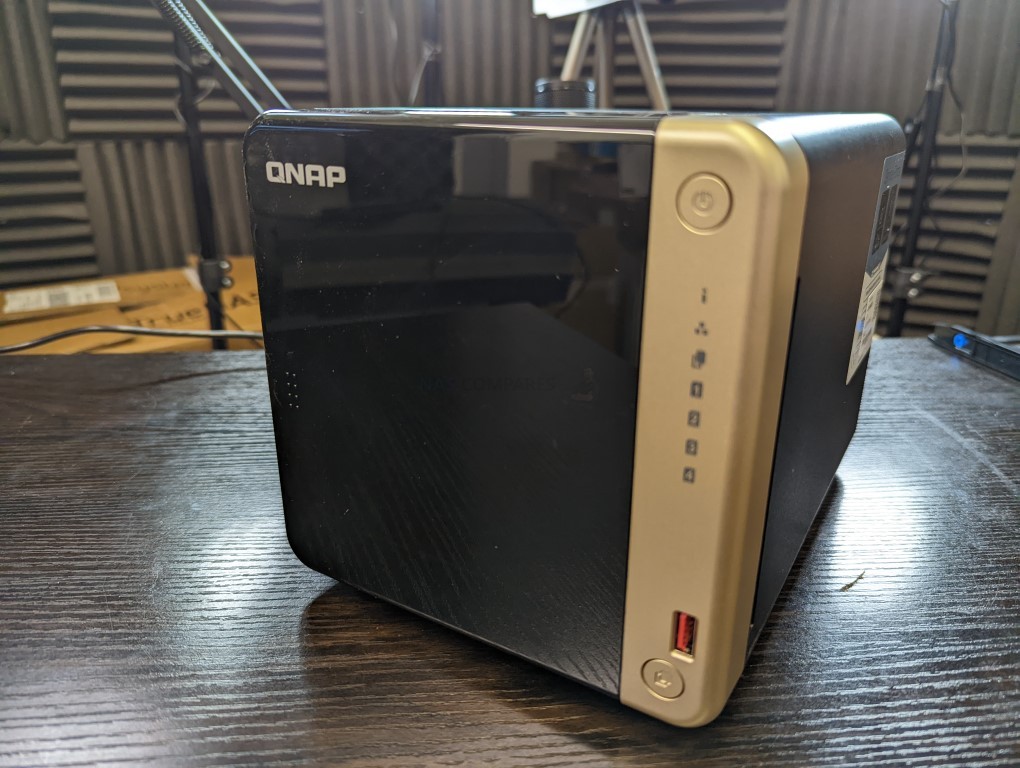 |
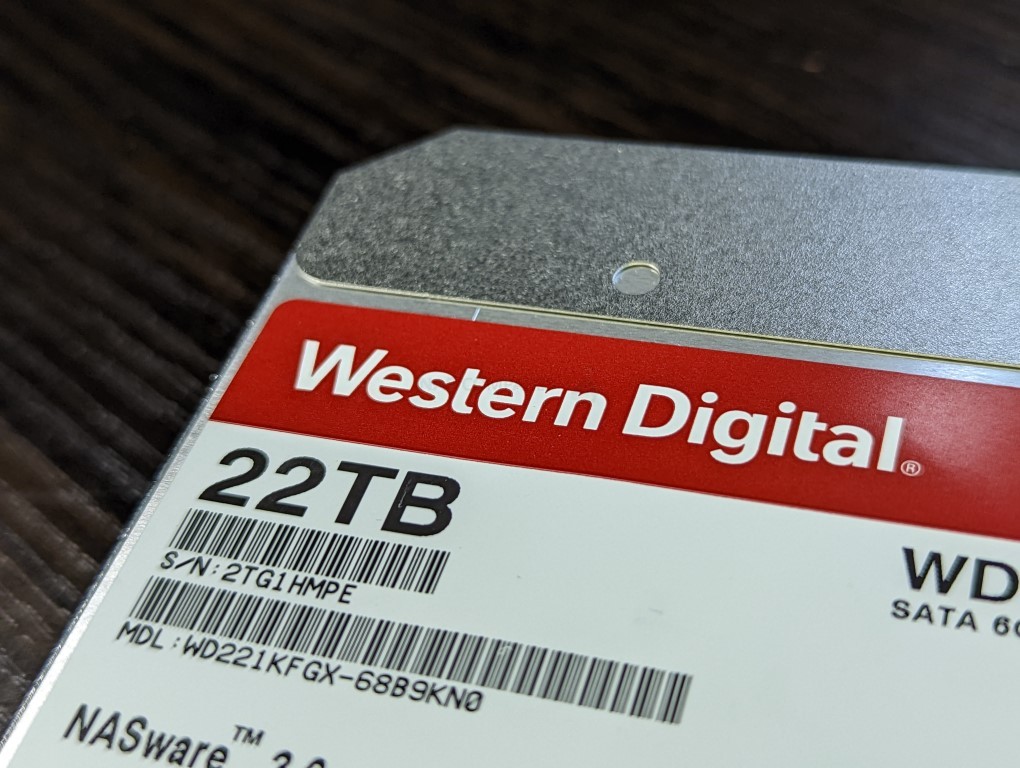 |
|
Intel N5105 CPU, 4-Core 2.0-2.9Ghz Celeron CPU
4GB 3200Mhz non-ECC Memory, 2.5GbE |
22 Terabyte Capacity – SATA 3.5″ Form Factor
7200RPM – 512MB Cache – 10x 2.2TB Platters
|
The initialization and RAID creation on the QNAP + WD Red Pro 22TB RAID setup took longer than the previous test and also resulted in a higher power consumption (with RAID ReSync set to High Priority) ending in 0.73kW (versus the 0.42 during the more modest Synology/WD Red Plus setup). Indeed, this continued into the 24hr active period, with this setup ending at 1.28kW use during high active use and 0.59kW during the 24hrs idle period.
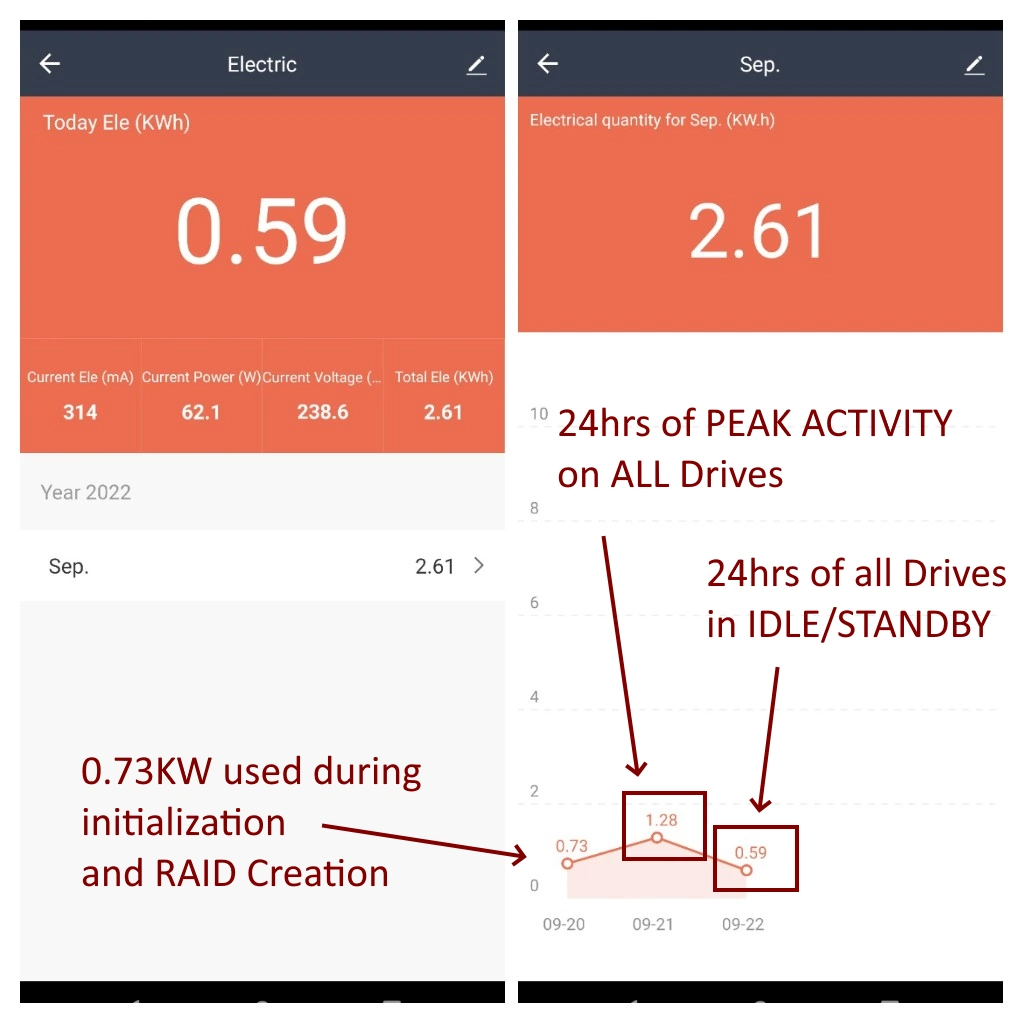
The difference that a more powerful/capable CPU and the more than 5x Capacity of those WD Red Pro drives did to the power consumption is pretty clear and certain. Let’s see how those results translated into your potential energy bills.
QNAP TS-464 NAS and WD Red Pro 22TB HDD Test Results:
1.28KW divided by 24 (hours) = 0.0533kW use per Hour
| 24hr Active Use (1.28KW) | UK Power Use | U.S Power Use | Germany Power Use | Australia | Canada |
| Cost Per Day | £0.4349 | $0.1893 | €0.4084 | AU$0.3018 | CA$0.1087 |
| Cost per Month | £13.22 | $5.75 | €12.42 | AU$9.17 | CA$3.30 |
| Cost Per Year | £158.73 | $69.09 | €149.06 | AU$110.15 | CA$39.67 |
0.59KW divided by 24 (hours) = 0.0245kW use per Hour
| 24hr Idle Use (0.59KW) | UK Power Use | U.S Power Use | Germany Power Use | Australia | Canada |
| Cost Per Day | £0.1999 | $0.087 | €0.1877 | AU$0.1387 | CA$0.05 |
| Cost per Month | £6.08 | $2.64 | €5.70 | AU$4.21 | CA$1.52 |
| Cost Per Year | £72.96 | $31.75 | €68.51 | AU$50.62 | CA$18.25 |
So, what about if you were to only use the NAS at active use for around 25% of the day (i.e 6hrs of active with backups, multimedia, etc) and 75% of the day as idle (i.e 18hrs unused):
25%/75% Active/Idle Use:
| 6hr Active Use / 18hr Idle | UK Power Use | U.S Power Use | Germany Power Use | Australia | Canada |
| Cost Per Day | £0.2586 | $0.1125 | €0.2428 | AU$0.1794 | CA$0.0646 |
| Cost per Month | £7.8665 | $3.4233 | €7.387 | AU$5.457 | CA$1.964 |
| Cost Per Year | £94.39 | $41.08 | €88.64 | AU$65.49 | CA$23.57 |
With the 25 % Active and 75% Idle ratio, the pricing on this high-capacity solution does seem alot more palatable. Still, there is no denying that in order to enjoy more modern large-capacity media, there can be a hidden cost as this technology becomes more industrious.
Test 3 – Synology DS1621+ NAS and 5x WD Ultrastar 10TB Drives
I set the Synology DS1621+ NAS and WD Ultrastar 4TB Hard drives up in the following configuration for the Active tests:
- Synology DS1621+ NAS PSU = 100W External PSU, Intel Celeron J4125 Quad Core 2.0-2.7Ghz, 4GB DDR4 2666Mhz Memory
- WD Ultrastar 10TB HDD, SHR
- Surveillance Station 9 and 2x Reolink Dome IP Cameras (24hrs Active)
- Synology Virtual Machine Manager, 1x Windows VM, 1 Core, 1GB Memory (24hrs Active)
- Synology Storage Manager (DSM 7.1) and S.M.A.R.T Tests per Hour (24hr Active)
- Reported Average power requirements of a WD Ultrastar 10TB (Single):
- 9.2W Active
- 8.0W Idle
|
The Synology DS1621+ NAS
Current Price/Availability on Amazon –$999+
|
The WD Ultrastar 10TB HDD (x5)
Current Price/Availability on Amazon –$259
|
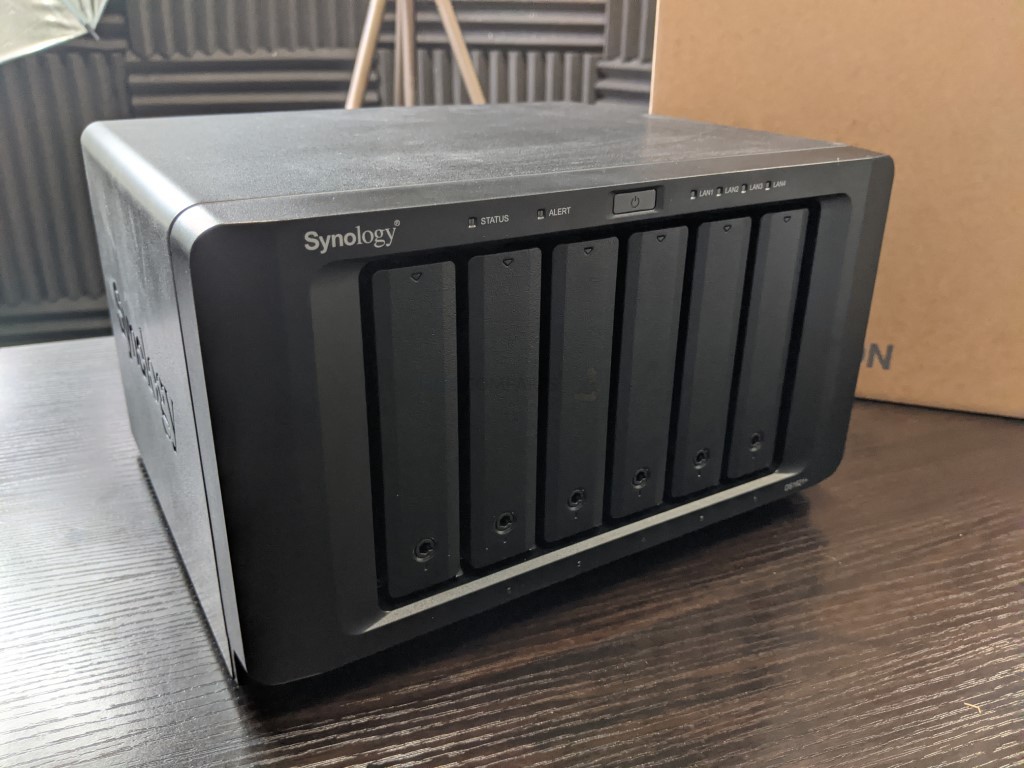 |
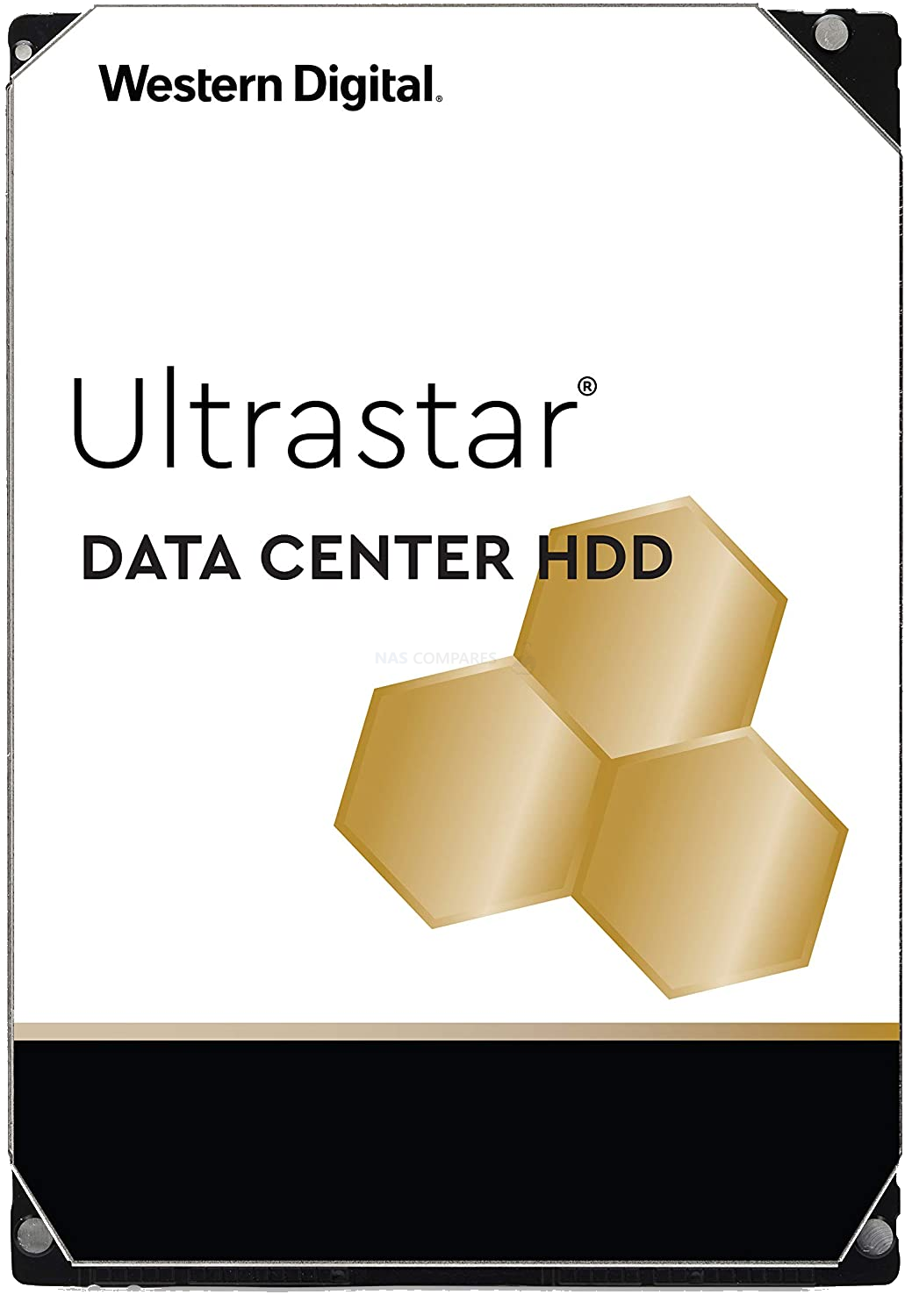 |
|
AMD Ryzen V1500B CPU, 4-Core 2.2hz Celeron CPU
4GB 2400Mhz ECC Memory, 1GbE |
10 Terabyte Capacity – SATA 3.5″ Form Factor
7200RPM – 256MB Cache – 6x Platters
|
Then, 24hrs later, I disabled all these processes, disconnected the RJ45 LAN and let the NAS fall into idle/standby mode. The results were as follows:
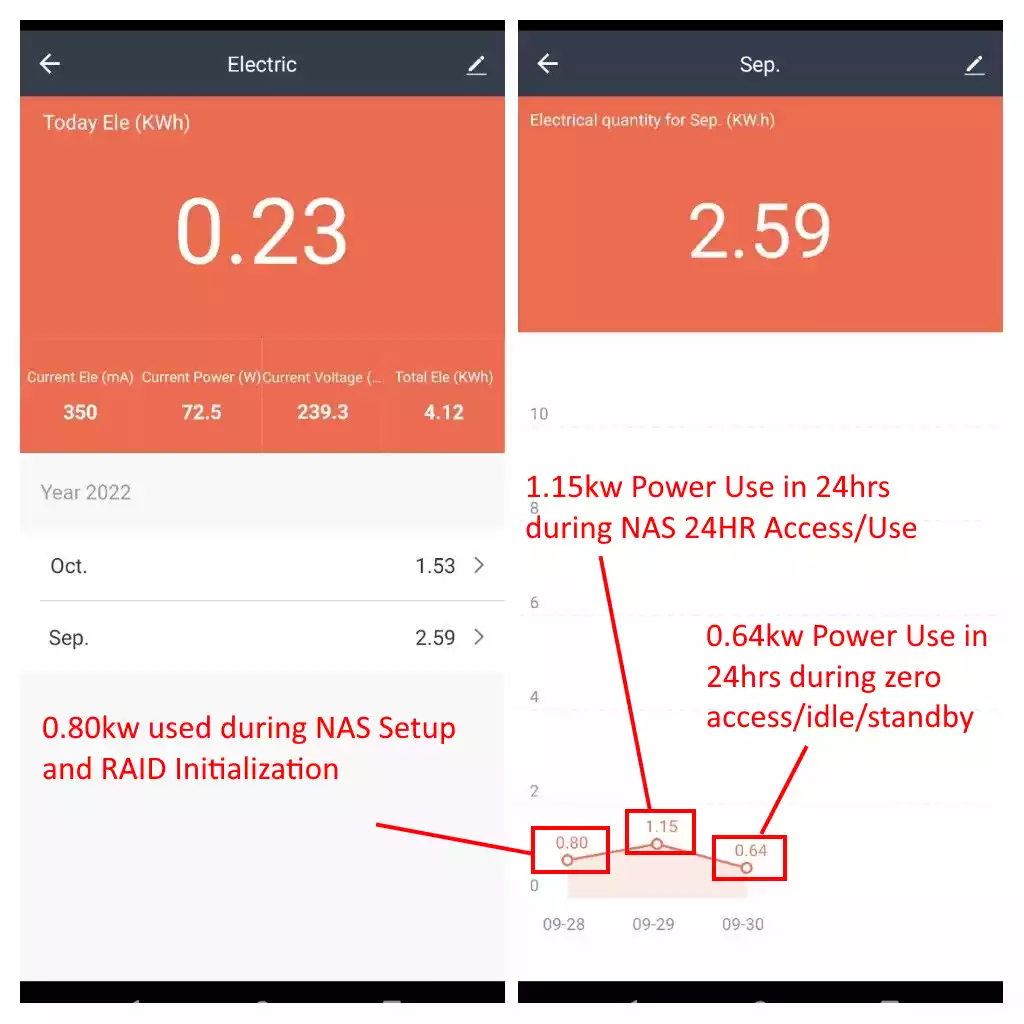
The 0.80kW that was used in the initialization of both the NAS and the drives in the RAID was NOT included in the respective Actie/Idle tests.
Synology DS1621+ and WD Ultrastar 10TB HDD Test Results:
0.0479kW use per hour active and 0.0266kW use per hour idle =
| 24hr Active Use (KW) | UK Power Use £ | U.S Power Use $ | Germany Power Use € | Australia AU$ | Canada CA$ |
| Per Hour | 0.016 | 0.007 | 0.015 | 0.011 | 0.004 |
| 24hr Idle Use (KW) | UK Power Use | U.S Power Use | Germany Power Use | Australia | Canada |
| Per Hour | £0.01 | 0.003 | 0.008 | 0.006 | 0.002 |
1.15KW over 24 hours Active =
| 24hr Active Use (KW) | UK Power Use £ | U.S Power Use $ | Germany Power Use € | Australia AU$ | Canada CA$ |
| Cost Per Day | £0.38 | 0.168 | 0.36 | 0.264 | 0.096 |
| Cost per Month | 11.68 | 5.11 | 10.95 | 8.03 | 2.92 |
| Cost Per Year | 140.16 | 61.32 | 131.4 | 96.36 | 35.04 |
0.64KW over 24 hours idle =
| 24hr Idle Use (KW) | UK Power Use £ | U.S Power Use $ | Germany Power Use € | Australia AU$ | Canada CA$ |
| Cost Per Day | £0.22 | 0.072 | 0.192 | 0.144 | 0.048 |
| Cost per Month | 6.57 | 2.19 | 5.84 | 4.38 | 1.46 |
| Cost Per Year | 78.84 | 26.28 | 70.08 | 52.56 | 17.52 |
So, what about if you were to only use the NAS at active use for around 25% of the day (i.e 6hrs of active with backups, multimedia, etc) and 75% of the day as idle (i.e 18hrs unused):
25%/75% Active/Idle Use:
| 6hr Active Use / 18hr Idle | UK Power Use £ | U.S Power Use $ | Germany Power Use € | Australia AU$ | Canada CA$ |
| Cost Per Day | £0.26 | 0.096 | 0.234 | 0.174 | 0.06 |
| Cost per Month | 7.8475 | 2.92 | 7.1175 | 5.2925 | 1.825 |
| Cost Per Year | 94.17 | 35.04 | 85.41 | 63.51 | 21.9 |
I will be conducting more tests with more NAS configurations in the coming months and either adding them to this article, or creating their own articles. Stay tuned, check below to see if other NAS power tests have been published and recommended to you, or watch the video version of these tests (which goes into more detail on the current predicaments in the energy crisis facing many of us in 2022, 2023 and beyond.
Test 4 – Synology RS422+ NAS and 4x HAT5300 16TB Drives
I set the Synology RS422+ NAS and HAT5300 16TB Hard drives up in the following configuration for the Active tests:
- Synology RS422+ NAS
- HAT5300 16TB HDD, RAID 5
- Surveillance Station 9 and 2x Reolink Dome IP Cameras (24hrs Active)
- Synology Virtual Machine Manager, 1x Windows VM, 1 Core, 1GB Memory (24hrs Active)
- Synology Storage Manager (DSM 7.1) and S.M.A.R.T Tests per Hour (24hr Active)
- Reported Average power requirements of a HAT5300 16TB (Single):
- 4W Standby/Idle
- 7.63W Active
|
The Synology RS422+ NAS
Current Price/Availability on Amazon –$799
|
The HAT5300 16TB HDD (x4)
Current Price/Availability on Amazon –$599
|
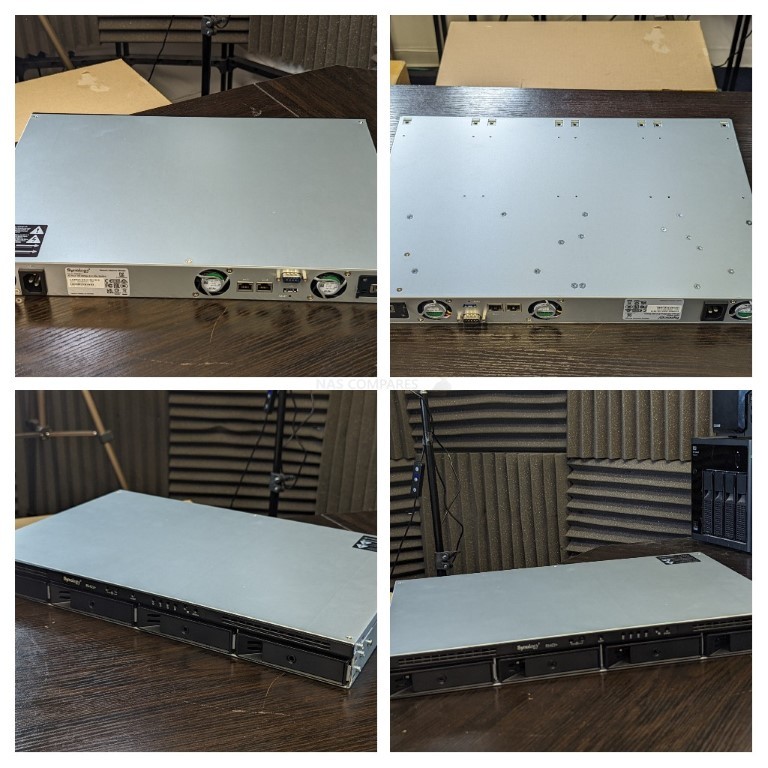 |
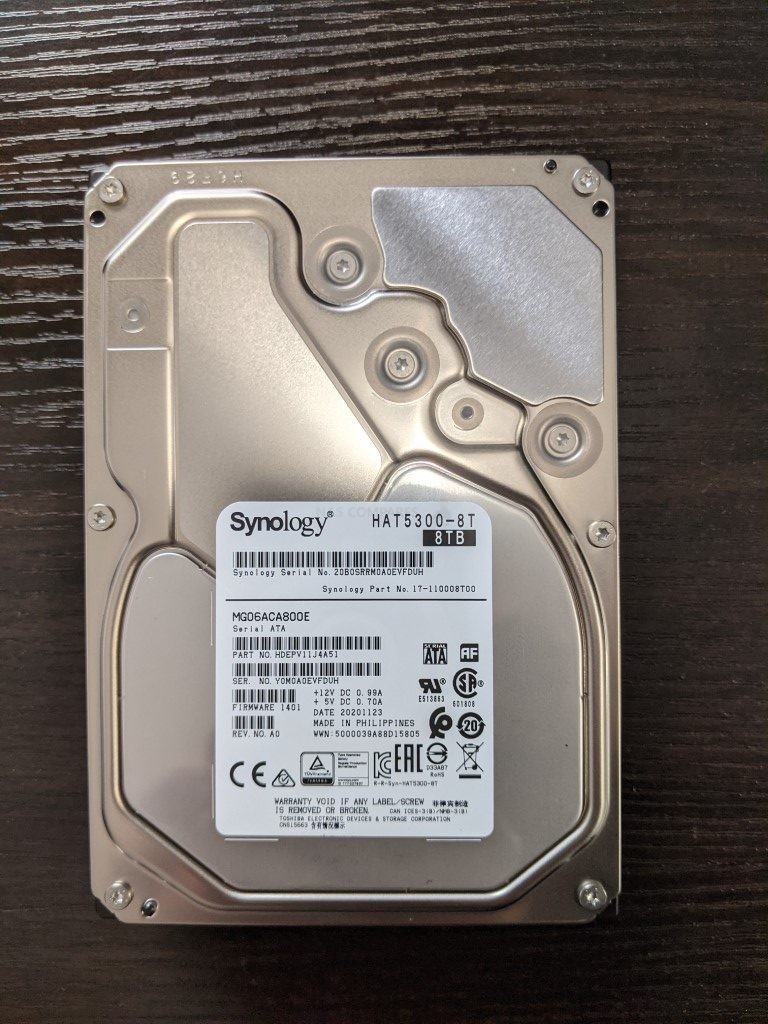 |
|
AMD Ryzen R1600 CPU, 2-Core 2.6-3.1hz Celeron CPU
2GB DDR4 Memory, 1GbE |
16 Terabyte Capacity – SATA 3.5″ Form Factor
7200RPM – 512MB Cache – 8 Platters
|
Then, 24hrs later, I disabled all these processes, disconnected the RJ45 LAN and let the NAS fall into idle/standby mode. The results were as follows:
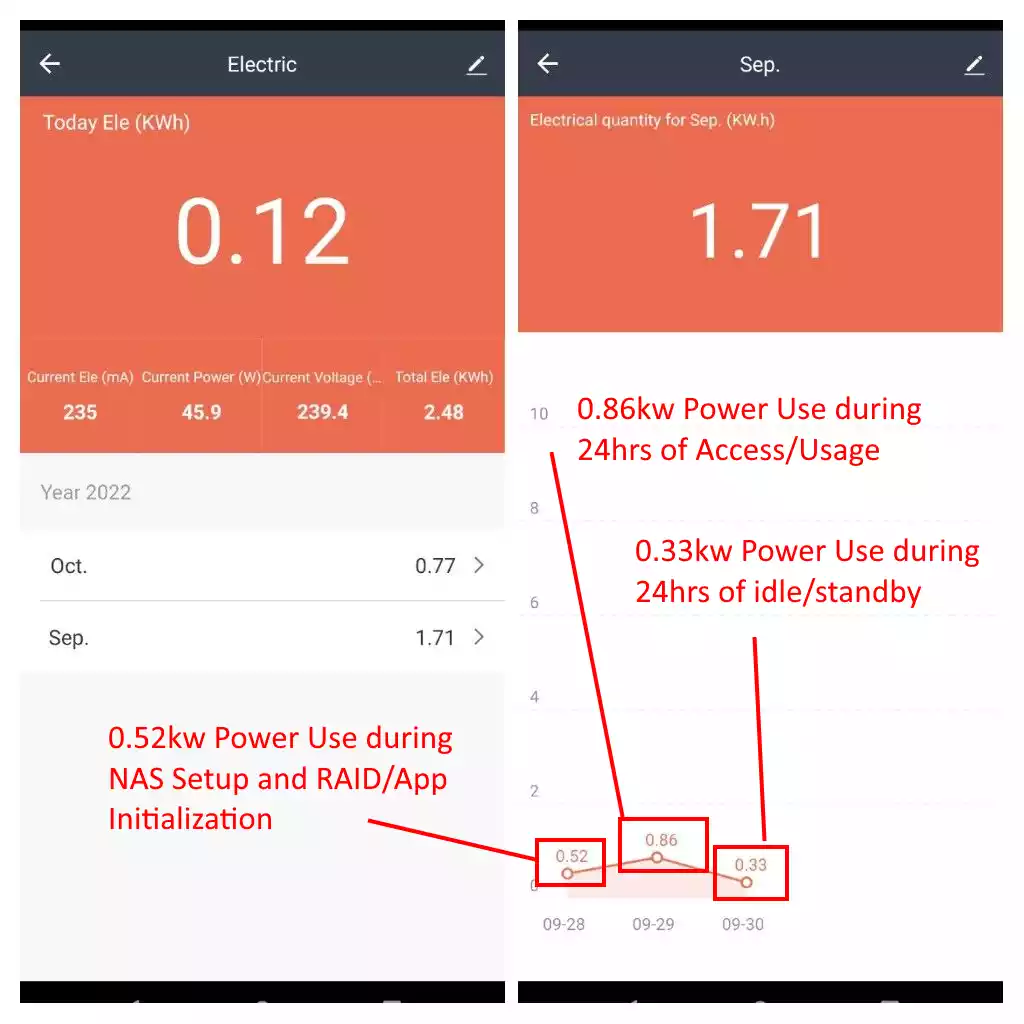
The power that was used in the initialization of both the NAS and the drives in the RAID was NOT included in the respective Actie/Idle tests.
Synology RS422+ and HAT5300 16TB HDD Test Results:
0.03583kW use per Hour in full access/use and 0.01375kW use per Hour in idle/standby:
| 1hr Active Use (KW) | UK Power Use £ | U.S Power Use $ | Germany Power Use € | Australia AU$ | Canada CA$ |
| Per Hour | £0.01 | 0.0053 | 0.0114 | 0.0085 | 0.003 |
| 1hr Idle Use (KW) | UK Power Use £ | U.S Power Use $ | Germany Power Use € | Australia AU$ | Canada CA$ |
| Per Hour | £0.00 | 0.002 | 0.0044 | 0.0032 | 0.0012 |
During 24hrs of Active/Full Use, 0.86KW:
| 24hr Active Use (KW) | UK Power Use £ | U.S Power Use $ | Germany Power Use € | Australia AU$ | Canada CA$ |
| Cost Per Day | £0.29 | 0.1272 | 0.2736 | 0.204 | 0.072 |
| Cost per Month | 8.906 | 3.869 | 8.322 | 6.205 | 2.19 |
| Cost Per Year | 106.872 | 46.428 | 99.864 | 74.46 | 26.28 |
During idle by 24 (hours) 0.33KW:
| 24hr Idle Use (KW) | UK Power Use £ | U.S Power Use $ | Germany Power Use € | Australia AU$ | Canada CA$ |
| Cost Per Day | £0.11 | 0.048 | 0.1056 | 0.0768 | 0.0288 |
| Cost per Month | 3.431 | 1.46 | 3.212 | 2.336 | 0.876 |
| Cost Per Year | 41.172 | 17.52 | 38.544 | 28.032 | 10.512 |
So, what about if you were to only use the NAS at active use for around 25% of the day (i.e 6hrs of active with backups, multimedia, etc) and 75% of the day as idle (i.e 18hrs unused):
25%/75% Active/Idle Use:
| 18hr Idle Use (KW)
6hr Active Use |
UK Power Use £ | U.S Power Use $ | Germany Power Use € | Australia AU$ | Canada CA$ |
| Cost Per Day | £0.16 | 0.0678 | 0.1476 | 0.1086 | 0.0396 |
| Cost per Month | 4.79975 | 2.06225 | 4.4895 | 3.30325 | 1.2045 |
| Cost Per Year | 57.597 | 24.747 | 53.874 | 39.639 | 14.454 |
Test #5 – QNAP TS-453E NAS and 4X 4TB WD Red Drives
I set the QNAP TS-453E NAS and WD Red 4TB Hard drives up in the following configuration for the Active tests:
|
The QNAP TS-453E NAS
Current Price/Availability on Amazon –$699+
|
The WD Red Plus 4TB HDD (x4)
Current Price/Availability on Amazon –$79
|
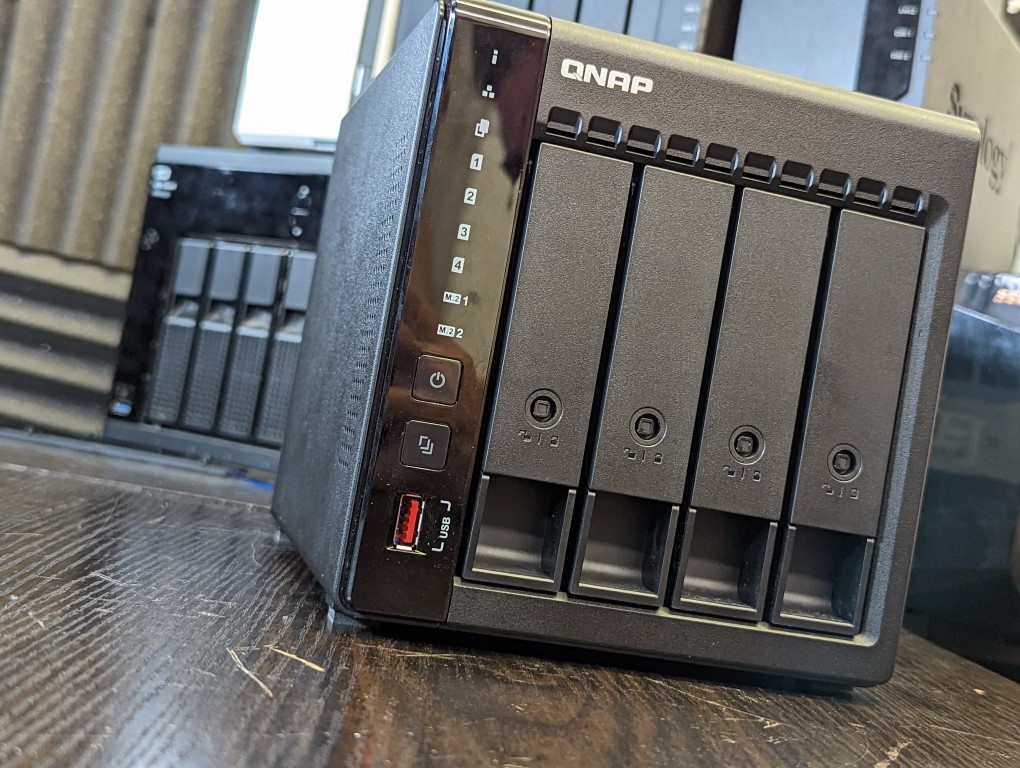 |
 |
|
Intel J6412 CPU, 4-Core 2.0-2.6Ghz Celeron CPU
8GB 3200Mhz non-ECC Memory, 2.5GbE |
4 Terabyte Capacity – SATA 3.5″ Form Factor
5400RPM – 64MB Cache – 4x 1TB Platters
|
QNAP TS-453E NAS PSU = 100W External PSU, Intel Celeron N5105 Quad Core 2.0-2.9Ghz, 4GB DDR4 3200Mhz Memory
- WD Red Plus 4TB HDD, RAID 5
- QVR Pro 9 and 2x Reolink Dome IP Cameras (24hrs Active)
- QNAP Virtualization Station, 1x Windows VM, 1 Core, 1GB Memory (24hrs Active)
- QNAP Storage Manager (QTS 5.1) and S.M.A.R.T Tests per Hour (24hr Active)
- Reported Average power requirements of a WD Red Plus 4TB (Single):
- Read/Write: 4.7
- Idle: 3.1
- Standby Sleep: 0.3
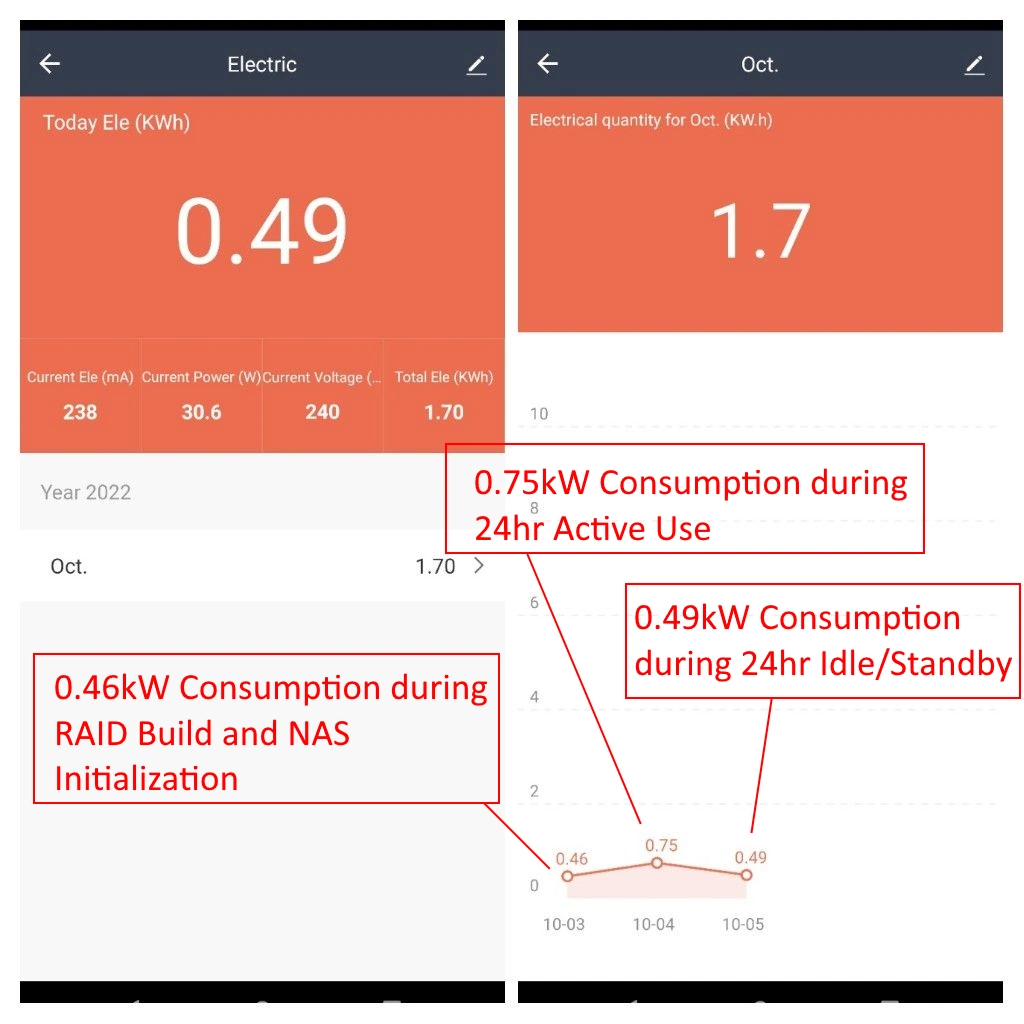
Let’s see how those results translated into your potential energy bills.
QNAP TS-453E NAS and WD Red Plus 4TB HDD Test Results:
0.03125kW use per Hour in full access/use and 0.0204166kW use per Hour in idle/standby:
| 1hr Active Use (KW) | UK Power Use £ | U.S Power Use $ | Germany Power Use € | Australia AU$ | Canada CA$ |
| Per Hour | £0.01 | 0.0046 | 0.01 | 0.0074 | 0.0027 |
| 1hr Idle Use (KW) | UK Power Use £ | U.S Power Use $ | Germany Power Use € | Australia AU$ | Canada CA$ |
| Per Hour | £0.01 | 0.003 | 0.0065 | 0.0048 | 0.0017 |
Here are the results for 24 HOURS OF ACTIVITY (no standby time or drive hibernation)
| 24hr Active Use (KW) | UK Power Use £ | U.S Power Use $ | Germany Power Use € | Australia AU$ | Canada CA$ |
| Cost Per Day | £0.25 | 0.1104 | 0.24 | 0.1776 | 0.0648 |
| Cost per Month | 7.738 | 3.358 | 7.3 | 5.402 | 1.971 |
| Cost Per Year | 92.856 | 40.296 | 87.6 | 64.824 | 23.652 |
Here are the results for 24 HOURS OF IDLE/STANDBY with no system use and ethernet/network connection disconnected
| 24hr Idle Use (KW) | UK Power Use £ | U.S Power Use $ | Germany Power Use € | Australia AU$ | Canada CA$ |
| Cost Per Day | £0.17 | 0.072 | 0.156 | 0.1152 | 0.0408 |
| Cost per Month | 5.037 | 2.19 | 4.745 | 3.504 | 1.241 |
| Cost Per Year | 60.444 | 26.28 | 56.94 | 42.048 | 14.892 |
So, what about if you were to only use the NAS at active use for around 25% of the day (i.e 6hrs of active with backups, multimedia, etc) and 75% of the day as idle (i.e 18hrs unused):
| 6hr Active Use and 18hr Idle Use (KW) | UK Power Use £ | U.S Power Use $ | Germany Power Use € | Australia AU$ | Canada CA$ |
| Cost Per Day | £0.19 | 0.0816 | 0.177 | 0.1308 | 0.0468 |
| Cost per Month | 5.71225 | 2.482 | 5.38375 | 3.9785 | 1.4235 |
| Cost Per Year | 68.547 | 29.784 | 64.605 | 47.742 | 17.082 |
Test #6 – Synology DS1522+ NAS and 5x WD Ultrastar 10TB Drives
I set the Synology DS1522+ NAS and WD Ultrastar 10TB Hard drives up in the following configuration for the Active tests:
|
The Synology DS1522+ NAS
Current Price/Availability on Amazon –$799
|
The WD Ultrastar 10TB HDD (x5)
Current Price/Availability on Amazon –$249
|
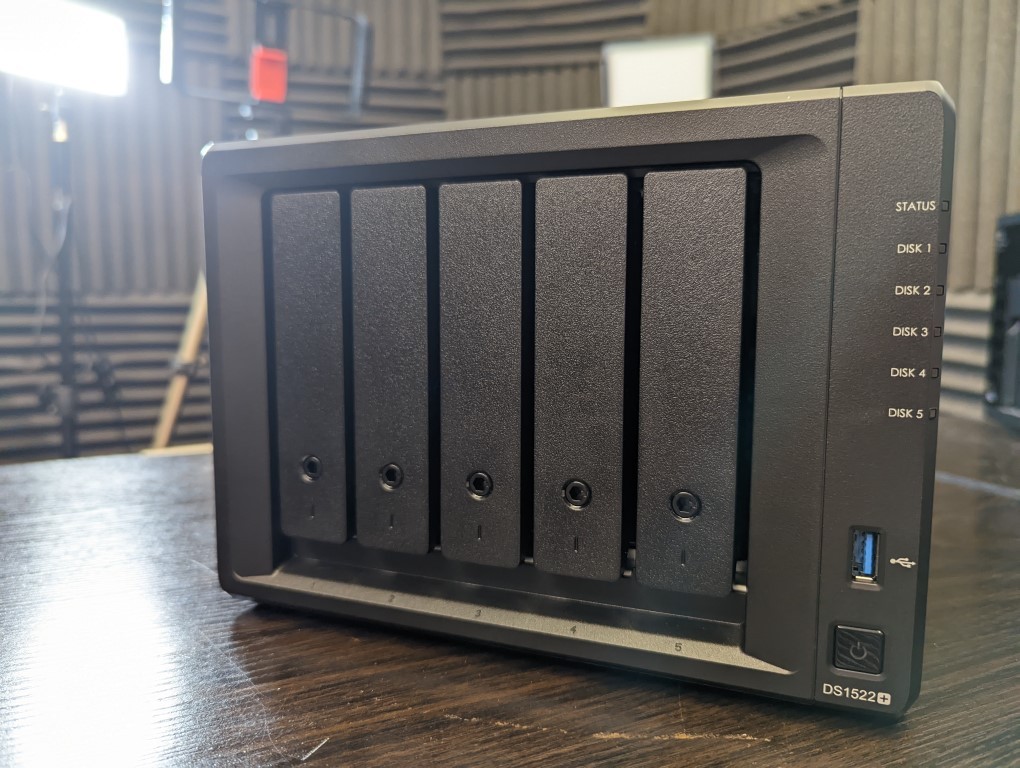 |
 |
|
AMD Ryzen R1600 CPU, 2-Core 2.6-3.1hz Celeron CPU
8GB DDR4 Memory, 1GbE |
10 Terabyte Capacity – SATA 3.5″ Form Factor
7200RPM – 256MB Cache – 7 Platter
|
- Synology DS1522+ NAS
- WD Ultrastar 10TB HDD, RAID 5
- Surveillance Station 9 and 2x Reolink Dome IP Cameras (24hrs Active)
- Synology Virtual Machine Manager, 1x Windows VM, 1 Core, 1GB Memory (24hrs Active)
- Synology Storage Manager (DSM 7.1) and S.M.A.R.T Tests per Hour (24hr Active)
- Reported Average power requirements of a WD Ultrastar 10TB (Single):
- 9.2W Active
- 8.0W Idle
Then, 24hrs later, I disabled all these processes, disconnected the RJ45 LAN and let the NAS fall into idle/standby mode. The results were as follows:
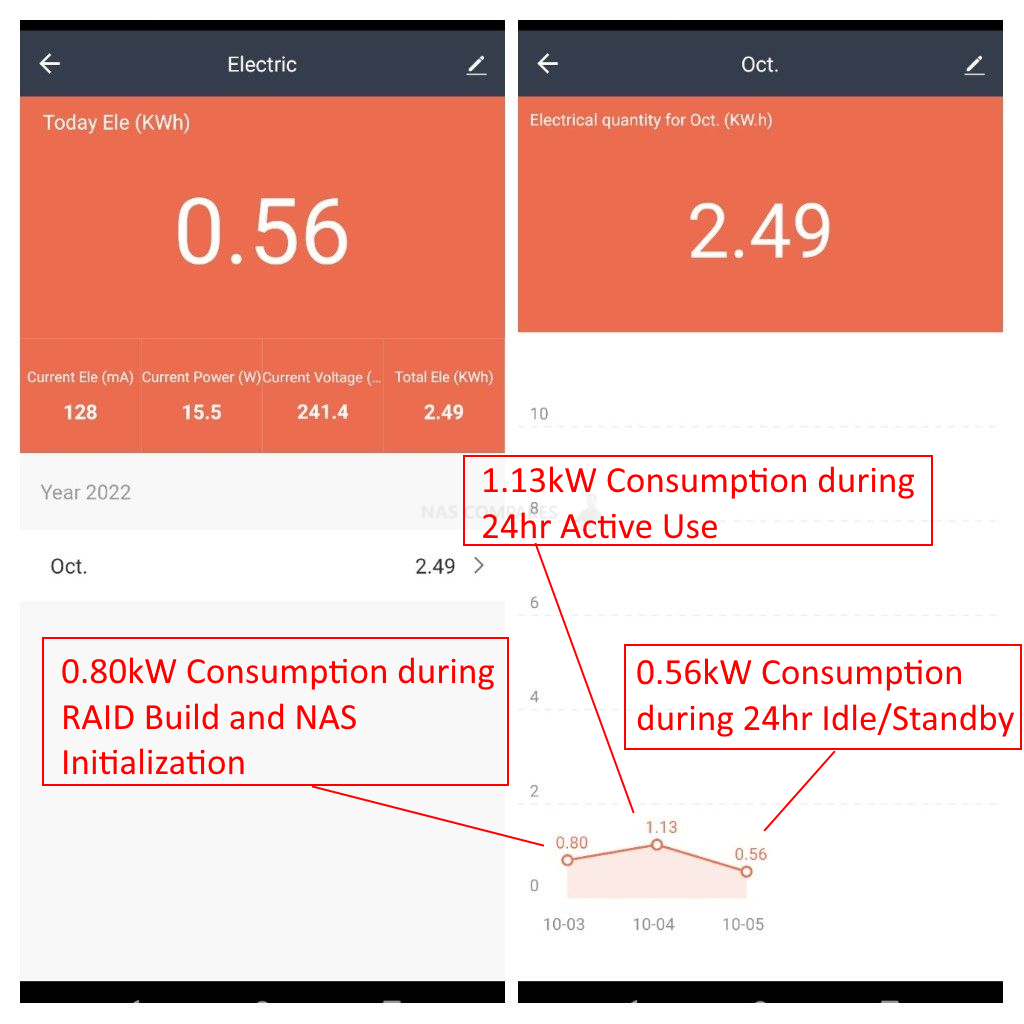
The power that was used in the initialization of both the NAS and the drives in the RAID was NOT included in the respective Actie/Idle tests.
Synology DS1522+ and WD Ultrastar 10TB HDD Test Results:
0.047083kW use per Hour in full access/use and 0.02333kW use per Hour in idle/standby:
| 1hr Active Use (KW) | UK Power Use £ | U.S Power Use $ | Germany Power Use € | Australia AU$ | Canada CA$ |
| Per Hour | £0.02 | 0.007 | 0.015 | 0.0111 | 0.004 |
| 1hr Idle Use (KW) | UK Power Use £ | U.S Power Use $ | Germany Power Use € | Australia AU$ | Canada CA$ |
| Per Hour | £0.01 | 0.0035 | 0.0074 | 0.0055 | 0.002 |
Here are the results for 24 HOURS OF ACTIVITY (no standby time or drive hibernation)
| 24hr Active Use (KW) | UK Power Use £ | U.S Power Use $ | Germany Power Use € | Australia AU$ | Canada CA$ |
| Cost Per Day | £0.38 | 0.168 | 0.36 | 0.2664 | 0.096 |
| Cost per Month | 11.68 | 5.11 | 10.95 | 8.103 | 2.92 |
| Cost Per Year | 140.16 | 61.32 | 131.4 | 97.236 | 35.04 |
Here are the results for 24 HOURS OF IDLE/STANDBY with no system use and ethernet/network connection disconnected
| 24hr Idle Use (KW) | UK Power Use £ | U.S Power Use $ | Germany Power Use € | Australia AU$ | Canada CA$ |
| Cost Per Day | £0.19 | 0.084 | 0.1776 | 0.132 | 0.048 |
| Cost per Month | 5.767 | 2.555 | 5.402 | 4.015 | 1.46 |
| Cost Per Year | 69.204 | 30.66 | 64.824 | 48.18 | 17.52 |
So, what about if you were to only use the NAS at active use for around 25% of the day (i.e 6hrs of active with backups, multimedia, etc) and 75% of the day as idle (i.e 18hrs unused):
25%/75% Active/Idle Use:
| 6hr Active Use and 18hr Idle Use (KW) | UK Power Use £ | U.S Power Use $ | Germany Power Use € | Australia AU$ | Canada CA$ |
| Cost Per Day | £0.24 | 0.105 | 0.2232 | 0.1656 | 0.06 |
| Cost per Month | 7.24525 | 3.19375 | 6.789 | 5.037 | 1.825 |
| Cost Per Year | 86.943 | 38.325 | 81.468 | 60.444 | 21.9 |
Test #7 – Synology DS2422+ NAS and 4x HAT5300 16TB Drives
I set the Synology DS2422+ NAS and HAT5300 16TB Hard drives up in the following configuration for the Active tests:
|
The Synology DS2422+ NAS
Current Price/Availability on Amazon –$1899
|
The HAT5300 16TB HDD (x4)
Current Price/Availability on Amazon –$599
|
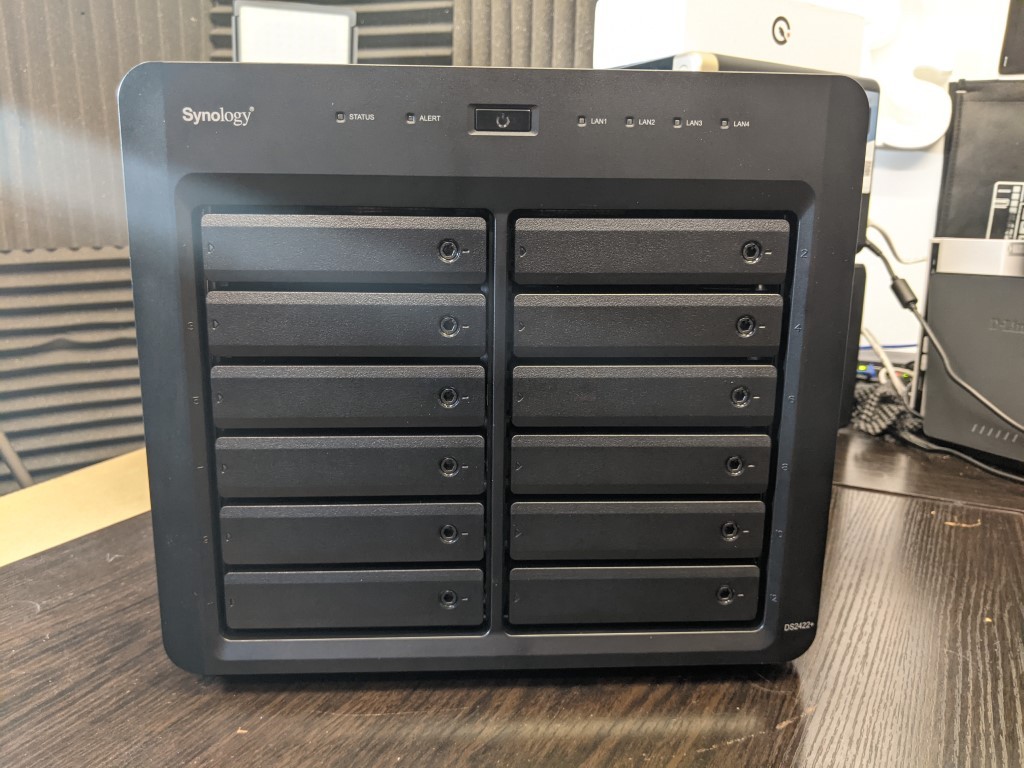 |
 |
|
AMD Ryzen V1500B CPU, 4-Core 2.2hz Celeron CPU
2GB DDR4 Memory, 4GbE |
16 Terabyte Capacity – SATA 3.5″ Form Factor
7200RPM – 512MB Cache – 8 Platters
|
- Synology DS2422+ NAS
- HAT5300 16TB HDD, RAID 5
- Surveillance Station 9 and 2x Reolink Dome IP Cameras (24hrs Active)
- Synology Virtual Machine Manager, 1x Windows VM, 1 Core, 1GB Memory (24hrs Active)
- Synology Storage Manager (DSM 7.1) and S.M.A.R.T Tests per Hour (24hr Active)
- Reported Average power requirements of a HAT5300 16TB (Single):
- 4W Standby/Idle
- 7.63W Active
Then, 24hrs later, I disabled all these processes, disconnected the RJ45 LAN and let the NAS fall into idle/standby mode. The results were as follows:
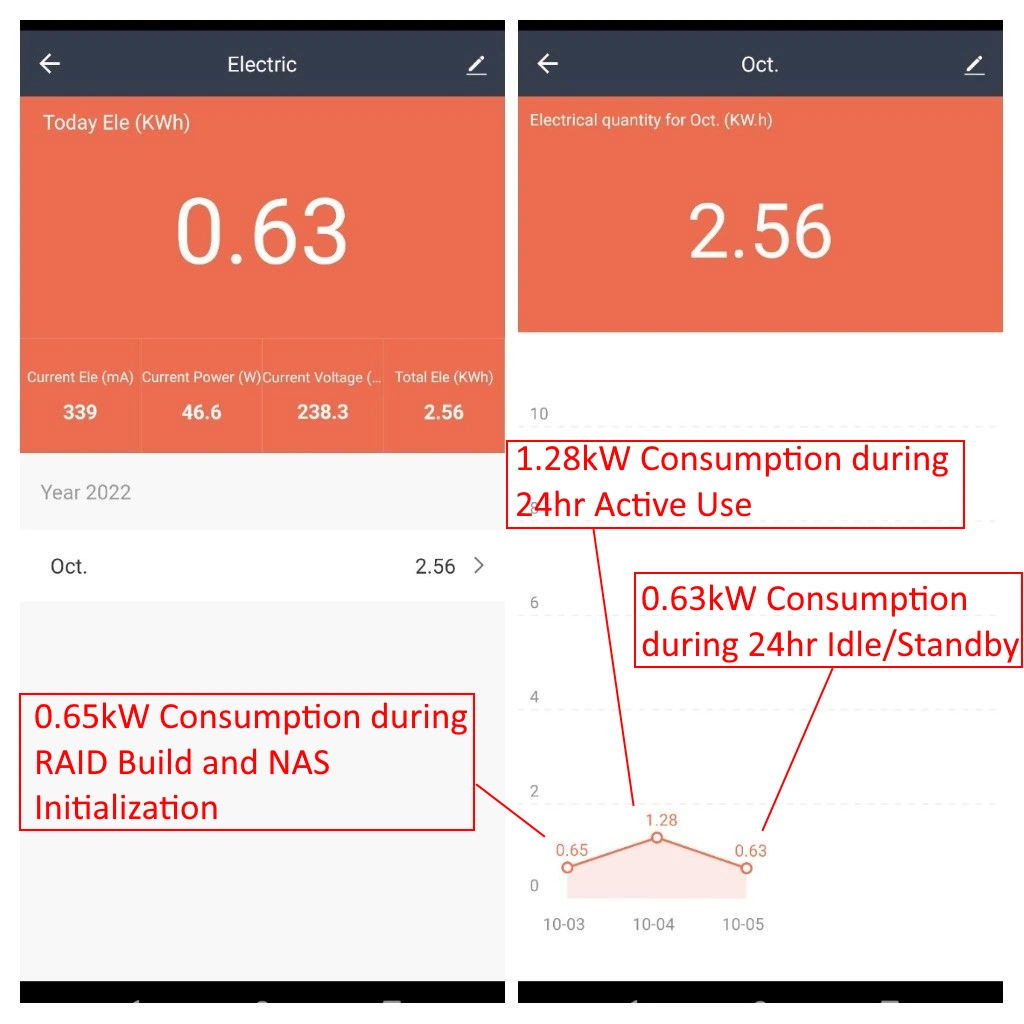
The power that was used in the initialization of both the NAS and the drives in the RAID was NOT included in the respective Actie/Idle tests.
Synology DS2422+ and HAT5300 16TB HDD Test Results:
0.053333kW use per Hour in full access/use and 0.02625kW use per Hour in idle/standby:
| 1hr Active Use (KW) | UK Power Use £ | U.S Power Use $ | Germany Power Use € | Australia AU$ | Canada CA$ |
| Per Hour | £0.02 | 0.0079 | 0.017 | 0.0126 | 0.0045 |
| 1hr Idle Use (KW) | UK Power Use £ | U.S Power Use $ | Germany Power Use € | Australia AU$ | Canada CA$ |
| Per Hour | £0.01 | 0.0039 | 0.0084 | 0.0062 | 0.0022 |
Here are the results for 24 HOURS OF ACTIVITY (no standby time or drive hibernation)
| 24hr Active Use (KW) | UK Power Use £ | U.S Power Use $ | Germany Power Use € | Australia AU$ | Canada CA$ |
| Cost Per Day | £0.43 | 0.1896 | 0.408 | 0.3024 | 0.108 |
| Cost per Month | 13.213 | 5.767 | 12.41 | 9.198 | 3.285 |
| Cost Per Year | 158.556 | 69.204 | 148.92 | 110.376 | 39.42 |
Here are the results for 24 HOURS OF IDLE/STANDBY with no system use and ethernet/network connection disconnected
| 24hr Idle Use (KW) | UK Power Use £ | U.S Power Use $ | Germany Power Use € | Australia AU$ | Canada CA$ |
| Cost Per Day | £0.21 | 0.0936 | 0.2016 | 0.1488 | 0.0528 |
| Cost per Month | 6.497 | 2.847 | 6.132 | 4.526 | 1.606 |
| Cost Per Year | 77.964 | 34.164 | 73.584 | 54.312 | 19.272 |
So, what about if you were to only use the NAS at active use for around 25% of the day (i.e 6hrs of active with backups, multimedia, etc) and 75% of the day as idle (i.e 18hrs unused):
25%/75% Active/Idle Use:
| 6hr Active Use and 18hr Idle Use (KW) | UK Power Use £ | U.S Power Use $ | Germany Power Use € | Australia AU$ | Canada CA$ |
| Cost Per Day | £0.27 | 0.1176 | 0.2532 | 0.1872 | 0.0666 |
| Cost per Month | 8.176 | 3.577 | 7.7015 | 5.694 | 2.02575 |
| Cost Per Year | 98.112 | 42.924 | 92.418 | 68.328 | 24.309 |
📧 SUBSCRIBE TO OUR NEWSLETTER 🔔
🔒 Join Inner Circle
Get an alert every time something gets added to this specific article!
This description contains links to Amazon. These links will take you to some of the products mentioned in today's content. As an Amazon Associate, I earn from qualifying purchases. Visit the NASCompares Deal Finder to find the best place to buy this device in your region, based on Service, Support and Reputation - Just Search for your NAS Drive in the Box Below
Need Advice on Data Storage from an Expert?
Finally, for free advice about your setup, just leave a message in the comments below here at NASCompares.com and we will get back to you. Need Help?
Where possible (and where appropriate) please provide as much information about your requirements, as then I can arrange the best answer and solution to your needs. Do not worry about your e-mail address being required, it will NOT be used in a mailing list and will NOT be used in any way other than to respond to your enquiry.
Need Help?
Where possible (and where appropriate) please provide as much information about your requirements, as then I can arrange the best answer and solution to your needs. Do not worry about your e-mail address being required, it will NOT be used in a mailing list and will NOT be used in any way other than to respond to your enquiry.

|
 |
Best NAS for under $499
Best NAS for Under $250 (2025)
Minisforum N5 Pro NAS - FIRST IMPRESSIONS
HexOS Q2 Update - What's Changed?
5 Exciting NAS Coming Later in 2025
Beelink ME Mini vs GMKtec G9 vs CWWK P6 NAS Comparison
Access content via Patreon or KO-FI


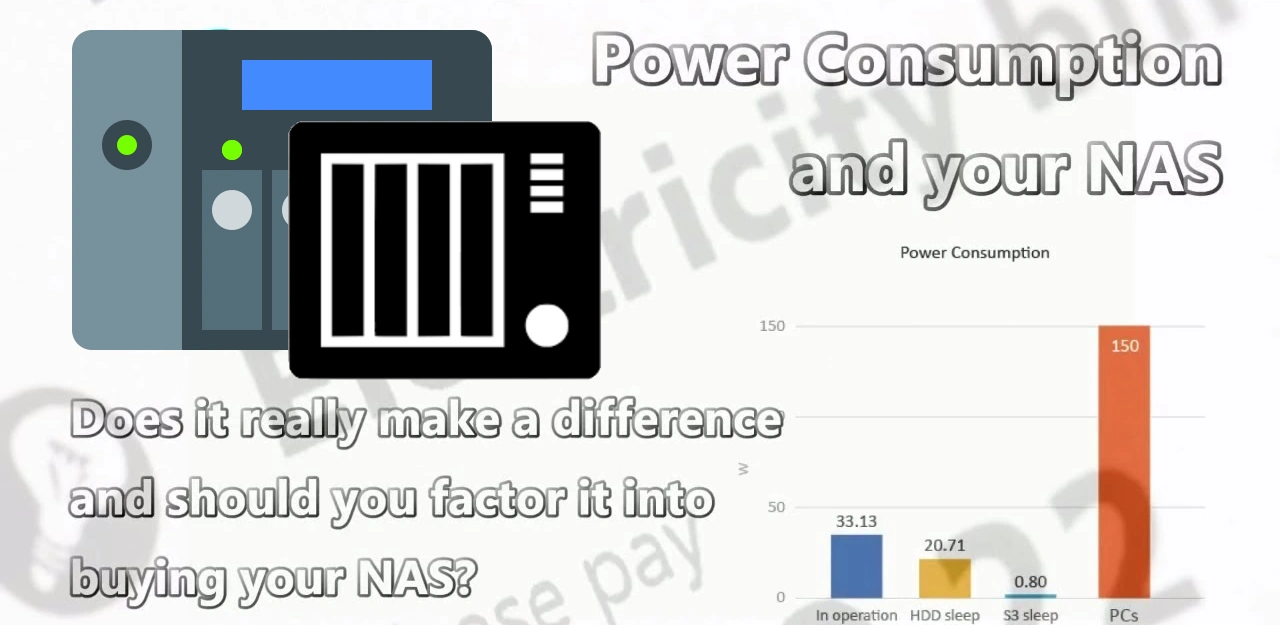



I ❤️ tips like these ???? Mine is in a cupboard and it does get hot in there during the summer but I had already thought about that and decided to have the door open in the summer.
I’m definitely on the fence about hibernation for the HDD, powering down the drives will help the cost of electricity but in the long run I think it will cost you more due to the HDD wearing out faster.
REPLY ON YOUTUBE
@NASCopares, how did you create the cartoon-like image of the NAS in the introduction at 2.05?
Want to do the same thing for use in Home Assistant with a floor plan.
REPLY ON YOUTUBE
Some say that turning on/off (thinking daily schedule) the drives will affect their longevity due to temperature fluctuations. What do you think?
REPLY ON YOUTUBE
Thanks – so average is about .35KW (350 Watts/day) – say 1/3 KW – not bad. I wonder what it would be with SSDs or NVME drives. The only issue I would see is if folks were trying to be off grid. In that case, I would not use the wall transformer and just run DC to DC from a battery bank (save another 20% or so).
REPLY ON YOUTUBE
Can I use SSD cache + moving DSM to SSD to maximize the HDD hibernation? Can you describe ho it is configured?
REPLY ON YOUTUBE
wol seems to be the only alternative provided by the nas to use as low energy as possible. but id rather use an android controlled energy plug. i dont want to use energy at all if im not using it
REPLY ON YOUTUBE
I pay total of 10$ a month for shared Disney+ (includes Hulu in my country), Max, SkyShowtime (Paramount+ and Showtime), Prime Video and Apple TV+. Plex+NAS+Usenet will cost me multiple times more. But in the end I’m just sick and tired of switching between all the services and usually not watching anything in the end, so it’s worth it. I will keep all the streamers mainly because of my kids and fairy tales in our language (Czech) but I barely watch anything on those already.
REPLY ON YOUTUBE
does keeping a NAS or other appliance in a sleep or hibernate mode apreciably increase the longevity of the hardware? or would the power cycling actually be more stressful for the PSU and motherboard.
REPLY ON YOUTUBE
Say 4 18TB drives active on DS920+ , how much power does it consume? To give more information say the drives are Seagate exos or WD ultrastar 18TBs. Not all drives are at full utilisation all the time.
REPLY ON YOUTUBE
I wonder whether the power consumption is the same in different countries given the differences in mains voltage. USA and Canada uses 120V, Australia uses 220-240V, Germany and UK uses 230V.
REPLY ON YOUTUBE
The most important part for all us nas newcomers 19:01
REPLY ON YOUTUBE
I dunno owning something is the coolest as you can play around
REPLY ON YOUTUBE
excellent job of explaining the electricity consumption
REPLY ON YOUTUBE
First of all, thank you for your channel. I’ve learned a lot!!! Considering DIY NAS with an SBC to replace a QNAP NAS. SBCs are affordable and customizable. They connect SATA drives and run Kodi. I’m interested in hearing your thoughts. Not sure if you covered this topic much. Thanks!
REPLY ON YOUTUBE
so pathetic. Brits destroyed their energy grid and now they are “saving” on NAS. ON NAS, KARL!
REPLY ON YOUTUBE
Capacity is a real issue
nowadays just pay streaming services and let them worry about all that 4k tv/movie capacity
i’ve swapped out all my tv/movie to flac music files on my NAS lol
REPLY ON YOUTUBE
nowadays these iptv catch up is quite cool
there is always great stuff in there that you can just click play and burn all your free time away
they are usually come included with your internet subscription
REPLY ON YOUTUBE
Disney+ is basically free with internet plan in certain countries lol
nobody really subscribe Netflix here
USA market is just one small part of the world
REPLY ON YOUTUBE
just do streaming hopping 1 at a time
no point paying for all and never watch them all at once 24/7
REPLY ON YOUTUBE
I’m looking to get a NAS for media streaming and private cloud. Is this possible? Or do they need to be dedicated to just one thing?
REPLY ON YOUTUBE
Dude, a word of advice: your videos are interesting yet tooooooooooooo bloody long. You repeat things 3, 4, sometimes even 5 times! And not just this one with the power utilization.
REPLY ON YOUTUBE
26:53 And that’s what a lot of people don’t seem to understand these days.That’s literally why i don’t like this digitalization of all these mediums. Especially gaming! I still buy all of my games PHYSICALLY! (Except for those that aren’t available to buy physically of course.) That’s really important to me. Now, we can see a clear trend that this IS GOING AWAY! And like you said: If the platform is gone, your media (whether it is games, movies, music,…) WILL BE GONE TOO!
I myself have Apple TV+ because there are a couple of good shows there and Netflix. I also have Disney+ but i pay my half with a friend of mine. But the movies i really want (in my case, movies like Harry Potter for example) i will actually buy physically.
Anyway, it is very convenient for sure. I don’t even think that’s half of the appeal, i think that might be 80% of the appeal. I mean, as long as you have an internet connection of course, you can watch it everywhere. In most situations. On your phone/tablet when you’re in a long car/train/bus,…. drive. When you are laying in the hospital, or whatever the case may be right? The ease of use/convenience is there.
Still though, you don’t own any of it, and that’s exactly what i have been saying for years already. Now, to each their own of course. Not everyone wants to buy their blu-rays (movies/series/music or games.) That’s absolutely fine. But i do think it is good to have options. We really need that. Once they remove that option and we are only left with streaming services. That becomes bad. Bad for us, the consumer that is. Because if you don’t own it, they can increase the price (and believe me, they will!) They can also take away those movies (for example Netflix has taken away all 7 Harry Potter movies on Netflix. At least here in Belgium.) I’m lucky enough that i own the Blu-rays. But it’s just an example. I really hope that physical media, whatever that media is, (Movies/games,…) will remain for as long as possible.
I must admit that i did thought that movies and music would come on an SD/USB device in this day & age. But i guess that would up the cost too much. A bit like the Nintendo Switch comes on those smal cartridges. I do like that a lot to be honest.
REPLY ON YOUTUBE
Was watching this video as well as your video on NAS Synology setup Part 1. I’m planning on buying a NAS although I haven’t yet. I’m planning on using it mainly for streaming videos to and from my Zappiti (a video media player device). On the Zappiti website they give instructions on setting up Zappiti with Synology’s Docker program. Do i need to do this or would I want to have it? Why or why not do this? thanks for any insights you may have
REPLY ON YOUTUBE
Why do you assume that people will subscribe to 5 streaming services? Nuts. Paid and Free streaming services killed personal collection. No need to own one locally.
REPLY ON YOUTUBE
Are you like this in real life? You’re rambling too much on ALL of your videos. Get to the point.
REPLY ON YOUTUBE
Great summary!!
REPLY ON YOUTUBE
Today to have a private server and private media server is expensive , just the hardware ,DS synology 920 about 500.00 four Nas hard fives 800.00 , add the electricity cost , well yes it’s expensive but more expensive will be to lose all the data . Just think about it!
REPLY ON YOUTUBE
Well, that was just FN brilliant. Thank you for your very wise words and thoughts about just buying you own media and storing it to a NAS. I think too, that owning your own media in form from DVD’s or Blurays is much better as in 20 years you can still watch the stuf or if you die someone from your familly can enjoy. You are a very nice guy, so keep up the good work you areer doing.
REPLY ON YOUTUBE
Glad you did this, as before lots will want to buy today, people will want to know how much these things cost to run.
Its important for many to understand before we buy what these things will cost to run.
REPLY ON YOUTUBE
Started a server build with around 24 drives for 600~700$, it will not only be for movies but also backing up my other NAS family photos.
REPLY ON YOUTUBE
That is exactly how objective tests must be done. Very good job!
REPLY ON YOUTUBE
Conclusion of this video: I move to Canada, Germany is way too expensive ????
REPLY ON YOUTUBE
That the power consumption is neglible highly depends where you live, for Germany that statement is wrong. A device pulling 50Wh straight for the entire year will cost you about 15€/month at current prices.
REPLY ON YOUTUBE
Unfortunately, most apps and plex on qnap prevent drives going to idle or standby. It is a pain as I only use plex some parts of the day, for example. Also, I do power down, but it is a real pain to.then schedule scans and raid scrubbing, etc, at the right times.
REPLY ON YOUTUBE
Yet another very helpful video. Big thank you to the whole team!
REPLY ON YOUTUBE
My TrueNAS is difficult to access, so I shutdown using a web browser on my phone, then restart with WON also on my phone.
REPLY ON YOUTUBE
Lower speed Nas helps. A 1gb ethernet uses less power than 10gb. Also pre-transcoding video can help reduce power, or choosing power friendly video formats.
Most folks should have a ups with a Nas, so maintain that. Look to totally kill the power during off time to save vampire power of the Nas psu during program off time using smart switches
REPLY ON YOUTUBE
Because of this video I just enabled WOL and auto-power-off on my DS1019+, if it works as expected I’ll keep it that way, thanks!
REPLY ON YOUTUBE
Maybe a nice experiment;
Get a set of solar-panels, fair size batteries (100h?) an (1000W?) inverter and make the NAS run only on solar power.
You probably need 400 ~ 500 Watt solar-panels to and both power the NAS and charge the batteries at the same time.
But that’s just a mind-melting idea I’ve been thinking about if that feasible.
(of course the solar panels might be prohibitively high)
Makes a nice coonversation-peace over a beverage of choosing 😉
REPLY ON YOUTUBE
I use a dual bay Nas, on bay 1 I have an SSD where I keep frequent used files, synch mobile phone and so and a bigger HDD in bay 2 for less frequent used files and let them enter sleep mode.
REPLY ON YOUTUBE
so … produce your own power and you dont have to worry about power consumption in terms of cost! gotcha 😀
REPLY ON YOUTUBE
Also, when letting the disks spin down or the NAS to power off you put extra wear on the drives shortening their life-span. Maybe you could save a bit on electricity but more than likely the premature failure of the disks will eat that up….
REPLY ON YOUTUBE
I went to 2.5 HDD… They are slower, but combined with SSD caching still faster then my network. 40% down in energy consumption, but it only makes sense from an economic / ecologic point of view, if you need new drives anyway. Otherwise its spending pounds to save pennies ????
REPLY ON YOUTUBE
As always, I really carefully watched the video, because your topics are always interesting. One thing you forgot to mention for not so experienced users – WOL working only when all devices are on the same network. AFAIK (please correct me if I’m wrong) you can’t use WOL from remote location via Internet.
REPLY ON YOUTUBE
Slightly OT… Robbie, would you consider doing a video on the economics of 4 bay vs 6 bay or 8 bay NAS ? I have a Synology DS920+ with 4 x 6 Tb drives running SHR which are getting quite full. I was planning to replace one of them with a single 16 Tb. But, using the Synology Raid calculator, I find that if I replace just one of the 6 Tb drives with a 16 Tb, the new drive will be recognized as a 6 Tb drive. So, I need to install in 2 x 16 Tb drives to get the benefit of the larger drive. And I will now have 2 x 6 Tb drives ( 12 TB total ) , which are otherwise quite serviceable, sitting on a shelf gathering dust. BUT… had I purchased a 6 or an 8 bay NAS, I could have just added the 2 x 16 TB drives AND kept 12 Tb of the old drive capacity. That is several hundred dollars / GBP’s of storage cost. I haven’t checked on the prices of said 6 and 8 bay NAS yet. And, further to the above bit of arithmetic, if I was running Raid 5 for example, I would have to replace ALL 4 of my 6 Tb drives, not just 2 of them. With a 6 or 8 bay NAS, I could have added additional 6 Tb drives until I ran out of bays. My next NAS is definitely going to be 8 bays as I would rather not use an expansion unit.
REPLY ON YOUTUBE
BTW, stop-starting mechanical HDD’s may affect their durability. You might save on energy but might lose on the lifespan of that drive.
Our record currently stands at 21 years uninterrupted ..
Granted, that is walking the thin line of failure but we like a good challenge.
REPLY ON YOUTUBE
As we have more than 1x NAS, we use them to warm-up the room and that works!
(18 to 19 degrees centigrade at the moment)
And don’t mind the noise, it is quite bearable unless you are sitting on top of the NASses.
Word of caution on WoL, that is standard that is only available on 1GBe ports, normally.
WoL is not supported on 10GBe ports (not part of the standards, I’ve checked) and possibly also not on 2.5GBe & 5GBe ports as the standards did not foresee that.
However, some brands (of switches etc) might support WoL on 2.5GBe/5GBe, check the documentation!
REPLY ON YOUTUBE
The amount of platters is often not published. At least for Western Digital it isn’t.
REPLY ON YOUTUBE
My drives on my 920+ never seem to hibernate. I have 2 setup on their own volume. I have a 4th disk setup with a second volume with the Surveillance Station recording to that drive, so I wouldn’t expect that one to hibernate. But I guess Surveillance Station keeps the other drives from hibernating as well?
REPLY ON YOUTUBE
Interesting. I have 8 bay nas with 4 filled hdd. From usually i pay 30$ bill without a nas, when my nas on 24/7 nas it goes up to 50$. Almost doubling what i usually paid for.
REPLY ON YOUTUBE
thanks for the video! very important video now that all the new NAS use more energy.
REPLY ON YOUTUBE
With nas can used native file manager and download from my ftp seedbox server in nas but i control all this from my phone ?
REPLY ON YOUTUBE
Interesting, as was a bit concerned about this you have given me some help with your suggestions. Thank you
REPLY ON YOUTUBE
I’m
Great video really useful insight on these units!
REPLY ON YOUTUBE
About 80% of the electricity produced in Canada is from green sources, most of it being hydroelectricity. Fossil fuel price fluctuations do not affect Canada very much. Most people I know refer to electricity as “hydro” because hydroelectricity is virtually the only source of electricity for us here in British Columbia.
REPLY ON YOUTUBE
Thanks for the video. Obviously, the energy consumption is mainly caused by the drives. Therefore, I am asking myself whether its worthwhile to have three 4TB HDDs in my new NAS with SHR in order to speed up the system or whether I should stick to two drives with lower energy consumption. What are your thoughts? Will 3 drives vs 2 increase speed significantly?
REPLY ON YOUTUBE
It’d be great to see this test done on a TVS-872X with those 22TB Pro drives
REPLY ON YOUTUBE
@NASCompares
Why does a HDD enclosure need a CPU and RAM?
REPLY ON YOUTUBE
I really appreciate these tests. When I’m working the energy consumption is less a concern because I’m getting value out of the system. However the idle consumption is of great importance for a 24/7 system.
So if my calculations are correct your tests show .59kwh *1000/24 = 24.6 watts idle power….that is not particularly good since I would hope for something more like <=10watts...maybe the Wrd reds are the way to go(maybe have to go back and look at that video)
REPLY ON YOUTUBE
Please test qnap ts251d, mine never stops spinning don’t know why, i end up turning it off because i worry about the cost especially now with things going crazy, also i get a bit of peace. I have a 2 bay with 2x 4tb ironwolf nas drives. Good show very interesting????????????????????
REPLY ON YOUTUBE
If you are using a UPS, the energy used is tracked and even generates reports on utilization and costs (all APC units have the software). Just plug in your current rates and reports can be automatically generated. These reports will generate hourly, daily, monthly, and yearly data.
REPLY ON YOUTUBE
I was looking forward to this video. I almost have the same setup.
REPLY ON YOUTUBE
That power meter your using, is it a proper power meter? The reason I ask, the cheap smart home plugs on show the average usage, not the actual…. It’s not showing the real value…if just a smart home plug.
REPLY ON YOUTUBE
I’d wrongly expect a pro drive to use less power. The reason for my though… if it’s pro it should be better, not worse. All those pro drives in service, would be wasting so much power in bulk…an a business would look to reduce costs….I’m wrong ????
REPLY ON YOUTUBE
12.8c/day CAD going off your numbers with the variable rates I get in northern Canada.
REPLY ON YOUTUBE
Would be interested to know about a QNAP TS-431X3 with 2 x WD80EFBX drives and 2 x WDS100T1R0A SSDs cheers! I have mine on 24×7 and thinking about doing some kind of scheduled power down (maybe when not in use?) and then i power on when i need them – to try and save power.
REPLY ON YOUTUBE
Hello. What 8-16TB hard drive would you recommend for a home server? I want it to be as quiet as possible.
REPLY ON YOUTUBE
I was already wondering, what it would “cost” me, running my TS253D with 2x8TB tochiba G08 disks .. thanks for the insights!
REPLY ON YOUTUBE
A very confusing video when you mistakenly use kW instead of kWh.
REPLY ON YOUTUBE
You also can take a IPTV subscription. xD
REPLY ON YOUTUBE
Just finished a CompTIA Net+, Sec+, and CCNA courses through the VA at an IT school for Veterans. Have applied to over 115 jobs in the past 2 months. Can’t get a job anywhere. Everyone wants you to have a PHD for an entry level IT job. It’s depressing and discouraging out here! So desperate for someone in IT somewhere to give me a chance to get started. Can’t get a job without experience, can’t get experience without a job. Yay.
REPLY ON YOUTUBE
Dude! You have to move your mic off that table. When you bump it, we hear it. It’s an easy fix. Love your channel, but come on man.
REPLY ON YOUTUBE
Surprised you didn’t mention playontv.
REPLY ON YOUTUBE
Me watching 3-4 movies a day while wfh ????
REPLY ON YOUTUBE
NAS costs lot more upfront but, after that you get what you own or download torrents… Also make up email accounts and get those free or cheap trials for streaming services etc.
REPLY ON YOUTUBE
Has anyone had the get a library card idea yet? Library cards are free, ripping movies are free and library’s are somewhat up to date with movies. ????
REPLY ON YOUTUBE
I only have prime but only because from my Amazon account. Watch 90% tv and movies from plex
REPLY ON YOUTUBE
Excellent video as always. I’ve recently stopped my service to hifi music streaming and am allocating that money to buying physical media that I own and store on my nas. I do retain one movie streaming service for reasons you mentioned, but ones that aren’t often available and I enjoy watching often I’m buying the box sets and ripping them to my nas so I always have them available to watch and I know I have them now forever. It’s almost hard justifying buying when we can just stream so much but I like the idea I own it now and it won’t just disappear once my subscription ends. When I originally bought my nas it was for a simple file server and backup until I found out how much these Synology devices are capable of. Now I can’t get enough of using it to its fullest potential. Many thanks to you for that!
REPLY ON YOUTUBE
What I’m doing: Netflix for convenience if the movie or show not on there I’ll buy it on apple tv if it’s a good price and they have it if not then it’s Plex time baby.
REPLY ON YOUTUBE
The hidden cost of STREAMING…. You missed the cost of the internet service.
Many people never factor in that cost.
REPLY ON YOUTUBE
You mentioned average prices of media you can own… the thing that gets me is that if you DO buy something from Google play, you still don’t really own it… you can only view it through their services… talk about misleading. The only way I can see that you truly own that media is buying a physical copy of it
REPLY ON YOUTUBE
Audio/Video sync is waaaaay out on this video.
REPLY ON YOUTUBE
I think these services are amongst the cheapest in India… $8 per month for Netflix, $12 for Amazon prime for a year and about $20 per year for Disney (includes live Sports) ???? .. I still use a NAS (on raspberry pi) for the shows which are no more available in any streaming services..
REPLY ON YOUTUBE
NICE
REPLY ON YOUTUBE
Great info as usual … just one quick question … I’m quite a tech guy and over the years I have built up lots and lots of family photos / videos and films on lots of usb hard drives … I think it’s time to get a “NAS” … do I need a special type of “NAS” for all of my media ??? As it’s mainly photos / videos ???
REPLY ON YOUTUBE
Great video. I think you missed a good chunk of streaming by not including music streaming in this calculation. Could be another almost 20 bucks a month for streaming service.
REPLY ON YOUTUBE
While owning physical media is great, and having those movies as part of a collection, There is the issue of disc rot, If you had discs laying around for a number of years, There’s always the possibility that the material that’s on that disc would start to deteriorate, and become unreadable, So I highly recommend you rip those discs and store them on your media server of choice as a backup, That way you have a perfectly good digital copy of your physical media. Software such as MakeMKV will allow you to rip all your DVDs and Blu-rays.
REPLY ON YOUTUBE
Thanks for adding chapters on your videos and a conclusion, ie pros and cons. Much improvement imo and thanks for your hard work!
REPLY ON YOUTUBE
We us our NAS/Plex server more as a giant DVR. We will subscribe to a premium service for a month and download everything we want from the service to Plex and then watch it at our leisure. The next month, we will pick a different service. Rinse and repeat every month. If it’s a show we like, we keep it. If not it’s deleted. I also had a huge DVD collection that I wanted to preserve.
REPLY ON YOUTUBE
I’m done sitting tight for the award advance since i acquire$23,000 every 12 days of my investment.
REPLY ON YOUTUBE
Another thing to consider is FTA (Free to air) on home theatre PC (HTPC). Our household has been using a HTPC with TV tuner card(s) since they arrived Win7 currently we can schedule recording on up to four channels in parallel. The main use is to avoid being forced into the schedule of the TV company, you can watch recordings in your own time plus occasionally archiving the interesting stuff . Another service we use it Kodi its worthwhile checking that out. How many people actually use HTPC with TV tuner cards these days? Streaming services seem to have killed them off.
I don’t recommend using enterprise grade SATA HDDs in a media storage device because they are very noisy and run at higher temps than consumer grade HDDs. They are designed for data centres not lounge rooms.
REPLY ON YOUTUBE
Netflix has just announced an ad supported tier. Presumably cheaper.
REPLY ON YOUTUBE
For those looking for free video content, here’s what I do. My local public library has a huge DVD movie, TV series, and documentary collection. Their collection is easy to search online and then simply click to reserve and have delivered to my local branch. I then use MakeMKV to rip the DVD to my hard drive in MKV format which is pretty much original quality. A bit redundant, but I then use Handbrake to make an MP4 copy which is far smaller and therefore a bit more portable when the need arises. Sure, the movies aren’t new releases, but there are thousands to choose from and everything is free, including MakeMKV and Handbrake. It’s all on my NAS for home viewing throughout the house. Alternatively, my local thrift stores sell movie DVD’s for around $2. I buy those occasionally, rip, and then donate to the library.
REPLY ON YOUTUBE
In the UK and some other European countries there is potentially also the cost of a TV licence ~£159. In the UK you can not watch live programming without a TV licence. Streaming of non-live content avoids this problem but one has to be careful. If you can be 100% sure you will not watch live TV then no problem.
REPLY ON YOUTUBE
For me, it’s convenience. I briefly thought about running a media server, and quickly decided I just don’t want to bother.
I can browse Netflix or Prime, choose what I want, and it’s streaming.
With physical media, I have to find and acquire the media (harder and harder to do), bring it home or wait for shipping, take the time to rip the disc, store it, worry about naming conventions and organization, back it up, figure out how to actually stream that media on the device I want to use. Yeah, I am so done with that.
REPLY ON YOUTUBE
Apples and oranges really, considering the content is often different, streaming always being the newest (except cinema ofc in some cases) and what most people are looking for. Bought media stored on a server will always play catch-up in that regard. Unless ofc we’re talking pi**cy, plus automation etc., which is entirely different, and naturally beating everything else. Illegal ofc ????
You rightly mention retention of your media. With streaming you have zero control, and your favorite movie/show can (and does) get yanked overnight. With a server you control it’s the opposite. Bottom line IMHO, the stuff you want to keep, get a copy you control, for everything else streaming is fine.
REPLY ON YOUTUBE
hulu bundles disney+ and ESPN for like, i dunno… 23$? maybe the price has gone up since the last time weve used it…
REPLY ON YOUTUBE
I think the trick is to use and manage all the above so that you get the most bang for your buck. I purchase the hard to find (and seldom streamed) titles, as well as my all time favorites for my NAS. I stream Prime and HULU, but I don’t really consider Prime because I would have it even if all I did was get free two day delivery. Add the free music and videos and it’s a no brainer. HULU is getting a bit pricey but they allow you to suspend your subscription which works out great when you’ve caught up with everything. All others like Paramount+ or Britbox and Acorn I usually wait till they have a trial of a dollar a month for 2 or 3 months. A very easy and cheap way to catch up on your favorites. Bottom line is, these are tough times and you have to make the dollar (or pound) stretch especially on discretionary spending.
REPLY ON YOUTUBE
Dave Gorman dvd ! Class ????????????????????????
REPLY ON YOUTUBE
You forgot one important consideration. Is your cable or DSL company. Sending all of that data across the internet, and if your provider has limits set on your data usage. You could get a huge surprise from them at the end of the month. Depending on your contract with them.
No.2 Back up, Back up, Back up. Granted a NAS will run you $400.00 and up. Consider two. Why ?
Should your power spike, local Tornado, Hurricane, system failure on one system. It’s electronics …It’s meant to fail at some point or another .
REPLY ON YOUTUBE
Good video; thanks! What I do (not possible everywhere): Movie pass for the local cinema; €240/year for watching unlimited new films + buy blu-rays for things I love and plan watching more than once; €200/year + occasional streaming services for binge watching series during holidays only; €40/year = €480/year (approx.) or €40/month. Next to this, for older content, I receive DVDs for free from friends or €1/each at the local thrift store.
REPLY ON YOUTUBE
Many thanks for another really useful topic. You mention the fiddly bit of transferring physical media to a NAS and this is one I’ve found difficult. Would welcome your thoughts on how best to do it for those of us with large physical media libraries.
REPLY ON YOUTUBE
I think that there is a point being overlooked in many of these cost calculations, and that is backups. Because when you buy physical media, not only does that give you legal access to the content, but if you are ripping it, then it is also a backup of all your content. I.e. if your NAS craps out/gets cryptoed etc, you can still re-rip from the physical media. Yes it’s a time-consuming process, but it is certainly better than just having one copy on a single NAS that you could lose. So if you do consider backups (and not everyone would otherwise have a backup, but I would, so this applies to my calculation) then you have to basically double at a minimum the cost of storage, which depending on how much media and what quality, is often the majority cost of a NAS setup.
REPLY ON YOUTUBE
Are we really afraid to mention torrents?
REPLY ON YOUTUBE
Give up for streaming NEVA~
REPLY ON YOUTUBE
One thing I’d be curious about is how this compares to an old computer that has been set up as a NAS. One of the things that people have always suggested to do with an older computer is simply re-purpose the computer and one use is as a NAS. My expectation would be that a purpose built NAS would be more energy efficient than a general computer used as a NAS, but I would wonder how large the difference would be.
REPLY ON YOUTUBE
I’m with e.on and the tarrif I’m on has cheap rates and standard rates through a 24 hour period, so I’d have to work out the cost on the standard rate and cheap rate per the hours.
I’m also running a more higher end NAS, DS3617xs & DX1215 both fully populated with 16Tb drives 12 Toshiba / 12 Seagate.
How about doing one on a PC’s PSU. I’ve got a gaming rig with a 1.2KW PSU but don’t play games much.
REPLY ON YOUTUBE
I’ve always powered off my ds 218+ if not used for a couple of days first thing because of power consumption second because i try to avoid hdd tear. Anyway thanks for this useful information and test
REPLY ON YOUTUBE
So if you had a Synology multi bay NAS is it possible to run the operating system, virtual machines docker images etc on SSDs ( 1 volume) and have all your extra data on mechanical drives (2nd volume – photos, movies music, personal files) so the power consuming volumes shut down when not being used to reduce power consumption? Data you keep may be many many terabytes but data you use constantly may only be Gigabytes. A home assistant container/VM may only be 32 GB. Multiple containers/VMs etc may be able to be run successfully on a single TB SSD.
Perhaps running all your apps/services on a Mac M1 chipped computer is the way to go. Heaps of power, low energy use for 24/7 home server. A mix of internal/external SSDs with an external HDD array for that mass storage – if energy consumption was your concern. Also has the power for everyday computing tasks as well.
My DS1821+, router, modem, switch & ups pulls from 110-130watts depending on load. Idles along around 110. My Mac mini idles along at about 9watts with 2 SSD drives. My Pi with a single SSD idles about 5 watts from memory. The Mac gives the best bang for buck but is not as easy to setup as the Synology for multiple services. The Pi is the cheapest to run but again not as easy to run as the synology for multiple services. How much is convenience worth? In my case if the Synology saves me 5 hours of my time a year it has paid for the electricity.
REPLY ON YOUTUBE
Great series of videos Robbie, loving the help you guys give.
REPLY ON YOUTUBE
My server uses 150w+ constantly ????
REPLY ON YOUTUBE
So my nas is costing me 57£ annually in UK
Damn
REPLY ON YOUTUBE
As someoen who’s’ avoiding paying for Cloud Storage this is a very important consideration.
However, I would assume many of us, such as myself, Cuttting that Cord/Bill with a more affordable (DS220+ / DS420).
It would be nice to see these more consumer levels NASs added to the mix. But for now, I’ll assume they are about the same or less than the 9+ series.
For Ontario Canada, average price is a little over 0.10c. But with the more complicated Peak, Mid-Peak, Off-Peak fees.
Assuming someone who’s using a NAS as I am, Photo/video storage, with the ocational evening video viewing, I’d be in idle more than 75% (honestly it’s more like 90% idle).
That said, we are looking at about $5 a year.
Looking forward to Eddie’s tool. that’ll be really nice 🙂
For reference I already have 2 WD 8TB Red Plus drive. I’ll be dropping them in a DS223+ or DS423.
REPLY ON YOUTUBE
Thanks, I was wondering how much it is costing to run NAS. Please could you do the DS920+ & DS118?
REPLY ON YOUTUBE
Best Home NAS drive for auto back-up of Android Mobile and Windows, preferably with NTFS file system?
REPLY ON YOUTUBE
both units use 95 watts/hr on average for both my DS1817+ and DS1821+ with 8 drives in both units
REPLY ON YOUTUBE
There seems to be some confusion about units here. A watt or kilowatt is a measure of power. Power is the rate of energy consumption. A watt (power unit) is one joule (energy unit) per second. To make the numbers simple, we measure electrical energy in watt or kilowatt hours, rather than in joules or kilojoules. A device running at 10 watts for 24 hours uses 10 x 24 = 240 watt hours (or 0.24 kilowatt hours) of energy. It is incorrect to use the term watts per hour, because a watt is a power measurement, not an energy measurement. I hope that helps.
REPLY ON YOUTUBE
Thanks for the analysis, super helpful.
REPLY ON YOUTUBE
1 part please…
REPLY ON YOUTUBE
I wish WD made a PR6100 so I could raid-5 that puppy on 5 disks and have a 6th as a hot spare in standby
REPLY ON YOUTUBE
Thanks! This gives a nice indication. I’m actually pleasantly surprised. I was expecting gloom and doom with this energy crisis
REPLY ON YOUTUBE
“your basic B NAS setup lol…made me laugh
REPLY ON YOUTUBE
In order to save some money I’m using the DSM scheduler feature to shut down a Synology DS220+ after 11H p.m. and power on from 8 a.m. every day. I wonder if this constantly power on/off cycles can stress the equipment and eventually make it less durable?
REPLY ON YOUTUBE
,please advise G2 video publish date,thanks
REPLY ON YOUTUBE
Thanks for the info, very helpful. I’ve been using the DS 918+ with 4 X 4TB Ironwolf drives, along with 2 X 512 M2 cache. I live on Vancouver Island, British Columbia, most of the power in the province is generated by hydro dams. So in comparison to the rest of Canada, we have relatively the cheapest energy in the country. I have a device that monitors my usage and I receive a weekly report. Throughout the summer, my usage is between $17 to $23 per week, that’s with a heatpump/airconditioner and all the other electrical devices in my home. My home was built in 2006, modern construction, airtight, 1,800 sqft rancher. I’m currently looking at finding a device(s) that will allow me to monitor all the equipment running in my office, home-lab, along with all my POE security cameras. This way I can break the usage down, so my wife will stop saying I’m using to much….lol
REPLY ON YOUTUBE
on Canadian rates – while it does vary province by province, yep – our electricity costs are indeed that cheap! hydro power makes things a lot cheaper over a long period, when dam construction are done. Ontario Hydro: ~$0.113/kWH; Manitoba hydro: $0.0932/kWH; BC hydro: $0.1132/kWH and Quebec Hydro: $0.06319/kWH.
REPLY ON YOUTUBE
Greetings from San Diego California. Our Summertime cost from SDGE for 24 hours would be $.2374. About 9 times the US average. We just love our fun and sun????.
REPLY ON YOUTUBE
Excellent advice
REPLY ON YOUTUBE
Very, very helpful. Thank you.
REPLY ON YOUTUBE
This can’t be a 2022 NAS Compares story without a PS5 test to add to the results ????
REPLY ON YOUTUBE
Remote places huh ???? ? I feel attacked watching from Ghana. ????
REPLY ON YOUTUBE
I recommend to get the 5TB Seagate Barracuda 2.5 inch drives for any home NAS. These drives can be harvested from inexpensive external USB drives, have the same 600000 load unload cycles as a WD RED and have up to 140 MB/s transfer rate. I have used three of these in a SHR RAID and one of them has already over 15000 hours of use. These drives will significantly reduce the power consumption of any 4 bay NAS.
REPLY ON YOUTUBE
Excellent job, very thorough & informative. I’m sure this will be helpful to alot of your viewers. Any possibility of this test on the TVS-872X or on the TVS-872XT which is pretty much the same system?
REPLY ON YOUTUBE
Man, this video is awesome! I love your channel.
I hope you’ll cover the WD PR4100 soon!
REPLY ON YOUTUBE
I’ve finally gone the DS920+ route after measuring my media server idle power over 24hrs. It’s really nice having a server to play with but it was costing me £20 per month and that is at September 2021 prices. On Saturday that becomes unafordable so my Plex library will live on the 920+
REPLY ON YOUTUBE
Would it be much of an issue if I shut down the Nas when not in use
How would it take to boot up looking at the Synology 920
REPLY ON YOUTUBE
i need more seagals 🙂
REPLY ON YOUTUBE
Great content my dude
REPLY ON YOUTUBE
I can’t believe this wasn’t a 2 day live stream ????????????
REPLY ON YOUTUBE
very much appreciate this video!
only (constructive comment) is that there are so MANY variables into actual power consumption from services being used and how often…data transfers being done and how often and the physical drives being used. BUT you did demonstrate how to do this so people can figure out their own power consumption.
REPLY ON YOUTUBE
I’d be interested to see how much lower the power consumption gets with an SSD-only NAS, it’s especially appealing because it would be completely silent AND power efficient.
REPLY ON YOUTUBE
Thanks. I have a QNAP TS-451+ whose drives always seemed to be doing something. It got so bad I turned it off for months as I didn’t want to pay for unnecessary electricity consumption. These days I keep it in sleep mode and wake it up for when I need it then back to sleep. Meets my user case but not everyone’s user case. Having installed LED lighting throughout the house I can’t justify an appliance on 24×7.
REPLY ON YOUTUBE
I’m in Quebec province and it’s cheaper then that. Here in Canada , we produce electricity with water ????, so much cheaper and we have a lot of rivers
REPLY ON YOUTUBE
Thanks man, very helpful.
I have been wondering how much my NAS is costing me and been powering down in the week to save el. More reassured that it is not costing a fortune and will leave it idled from now.
REPLY ON YOUTUBE
I have Xpenology with HP microserver gen8 + 3x 4tb red plus and the consumption is 38watts in Idle. I want to buy the new ds923+ to also divide by 2 this consumption.
REPLY ON YOUTUBE
10:44 Time Stamp : You say that 4x4TB WD RED NAS plus Synology DS920 consumes at full load 21,25Watts
WD Official Data Sheet for these drives give 3.8 Watt concumption (x4= 14.4 Watt for drives)
Synology Inc. at specification sheet of Ds940+ giving:
Power Consumption* 32.17 W (Access) 9.69 W (HDD Hibernation)
British Thermal Unit 109.84 BTU/hr (Access) 33.09 BTU/hr (HDD Hibernation)
Notes
Power consumption is measured when it is fully loaded with Western Digital 1TB WD10EFRX hard drive(s).
Noise Level Testing Environment: Fully loaded with Seagate 2TB ST2000VN000 hard drive(s) in the idle state. Two G.R.A.S. Type 40AE microphones, each set up 1 meter away from the Synology NAS at the front and rear. Background noise: 16.49-17.51 dB(A); Temperature: 24.25-25.75˚C; Humidity: 58.2-61.8%
Power Management10 for WD10EFRX (WD Official Data Sheet)
12VDC ±5% (A, peak) 1.75
5VDC ±5% (A, peak) 1.00
Average power requirements (W)
Read/write 3.3
Idle 2.3
Standby and sleep 0.4
So if we say that 4xWD10EFRX have a concumption of 13.2Watts (as mentioned from WD official data sheet), The host machine Synology DS920+ consumes for itself 32.17-13.2 = 18.97 Watt
Now if we add the power concumption of 4x4TB WD RED NAS we take: 18.97 + 14.4 = 36.97 Watts!!! And if we multiply this number by 24 times , we have: 0.887 KWh/day whichn means 26.6KWh per month or 320KWh annualy.
Multiplay now this number with your local charges for electrik energy to find the exactly power cost for this machine.
Do not forget to calculate any penalties for overconcumption wich applied in some countries after a basic amaount of energy consumption.
Higher capacity drives have higher consumptions which can touch even 10Watts per drive for 16TB 18TB 20TB and 22TB drives.
I think that you have issue with your energy counters. The simlest and more reliable method is the usage of a “Kill a Watt” meter directly between machine`s fis and wall source.
REPLY ON YOUTUBE
Appreciate the effort going into this, but gonna say you’ve set yourself an impossible task. At least here in the USA, per KWh pricing is all over the map, even trying to take a “national average” is not going to mean much other than a tiny slice that are at the average. Plus residential rates can vary vastly from commercial rates, even in the exact same locale. Like I’m in Virginia and pay $.10/KWh fixed, yet a friend in Boston pays $.32 and is on variable rate that changes at different times of the day.
IMO where the value you can offer comes in you and Eddie gathering and comparing load/no-load/typical-load consumption data across a range of “typical” NAS setups, and leave it to the viewer to calculate what that means for a local “price to operate”. All caveats aside, I think you’re creating a bunch of extra work for yourself that in the end a potential NAS user is going to have to figure out on their own.
REPLY ON YOUTUBE
nice work thanx boss
REPLY ON YOUTUBE
Great idea! Thanks for the video.
REPLY ON YOUTUBE
Have not finished your video yet, so sorry if it is answered but can ssd cache THEORETICALLY reduce power consumption if I use services like Sonarr or Radarr that periodicaly scan and download media to my server? (Sonarr and Radarr run on my Mini pc, not synology ds920).
Also are bigger harddrives more power hungry? I have wd red plus 8tb.
Btw your videos are perfect, I am still watching your stuff even months after I bought my NAS and set up everything I needed, thank you for your work!
REPLY ON YOUTUBE
NAS power consumption only matters in the summer. In the winter, NAS energy just contributes to heating the house.
Fan speed can affect power consumption. I set mine in the middle.
REPLY ON YOUTUBE
great idea for a video. currently I have a ts-464 with four 12GB ironwolf drives and I’m looking forward the next video cause it’s closer to my setup.
REPLY ON YOUTUBE
Folkestone is quite remote….I hope you cover us ????
REPLY ON YOUTUBE